BISC 202 post-midterm (W6-13)
1/295
There's no tags or description
Looks like no tags are added yet.
Name | Mastery | Learn | Test | Matching | Spaced |
|---|
No study sessions yet.
296 Terms
what is the most unique thing about sexual reproduction compared to asexual reproduction?
sexual reproduction produces individuals with new genetic combinations, as the alleles from two sources mix and produce a genetically-distinct offspring
sex and reproduction in eukaryotes and prokaryotes
in many diploid eukaryotes, sex and reproduction occur in a single event, sexual reproduction, so the mixing of alleles from two sources immediately produces a genetically distinct offspring
in prokaryotes, sex, which is making new genetic combinations, and reproduction, which is making new cells, are separate events
reproduction in prokaryotes
in prokaryotes, there is no meiosis and cells divide by binary fission
prokaryotes only have one circular chromosome, and sometimes some small circular plasmids, they are not diploid
sex in prokaryotes

conjugation
a “donor” cell forms a pilus that can attach it to a “recipient” cell
it can then transfer a copy of a plasmid (or even parts of the chromosome) to the recipient cell
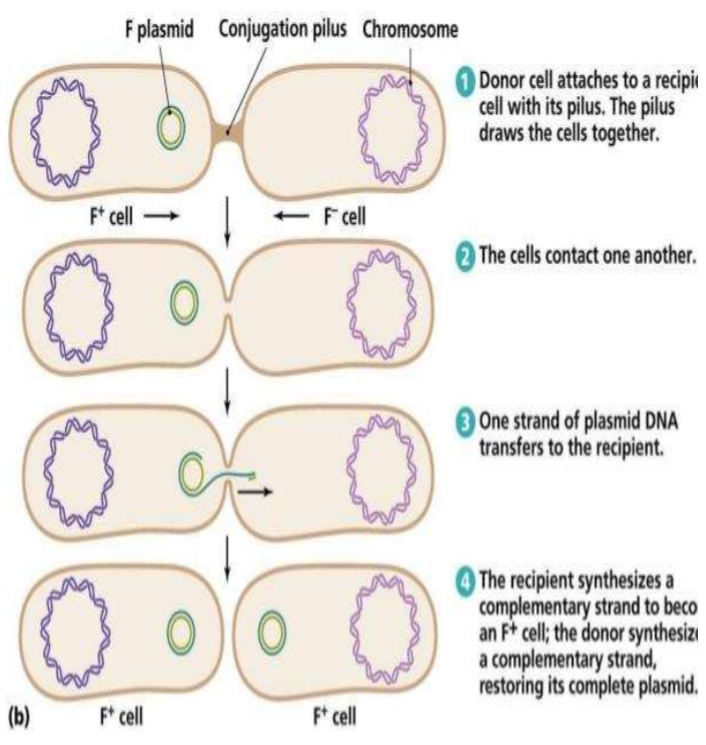
transformation
a recipient cell can pick up DNA fragments from the surrounding environment and incorporate pieces of it into its genome through pairs of crossover events
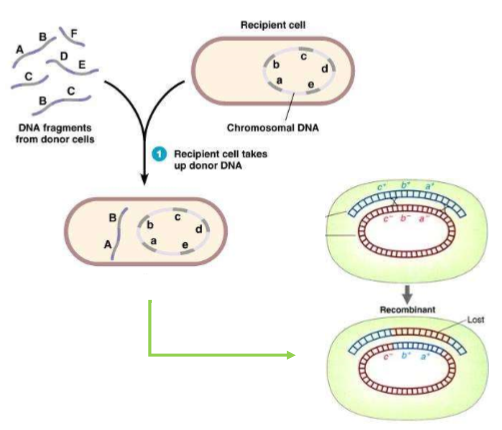
transduction
a bacteriophage (a bacteria infecting virus) can transfer some DNA from its previous host into the recipient host cell
normally, phages only hold phage DNA, but sometimes the new phage protein coat accidentally carries some bacterial DNA, instead
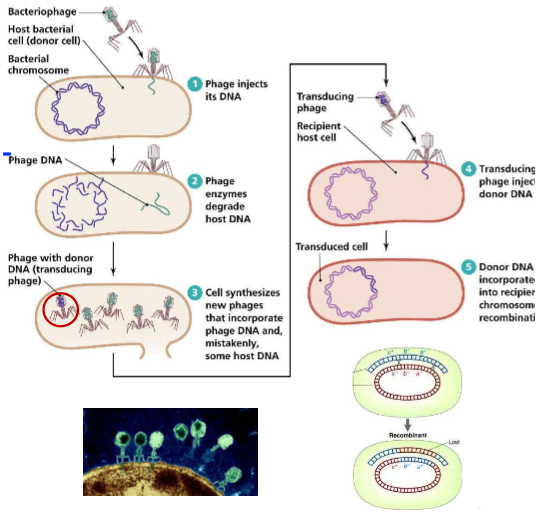
advantages of working with bacteria
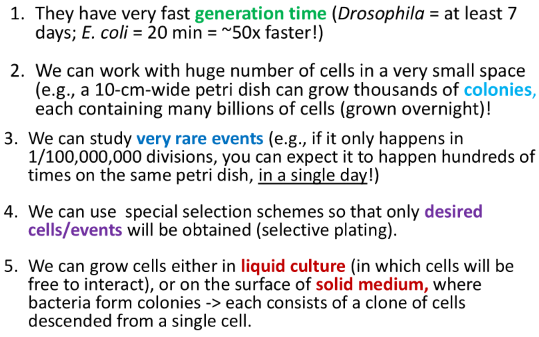
selection systems
kill or prevent growth of cells that don’t have the trait we want, so that we can pick out one or a few cells with the desired trait form among billions of cells
ex. antibiotic resistance, metabolic requirements
antibiotic resistance
grow cells in large numbers in liquid culture lacking the antibiotic - then “plate” large numbers of cells onto solid medium containing the antibiotic; the few cells that grow have gained resistance and their descendants form colonies
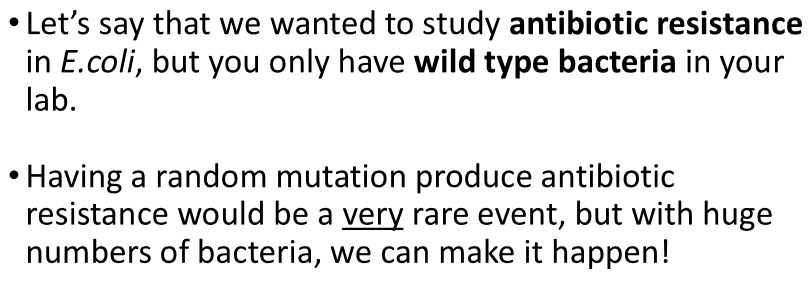
metabolic requirements
grow cells in liquid culture containing particular nutrients, and then plate large numbers of cells onto solid medium lacking these nutrients; only cells that can produce the missing substances will survive
what is one way to isolate cells with particular mutations/alleles?
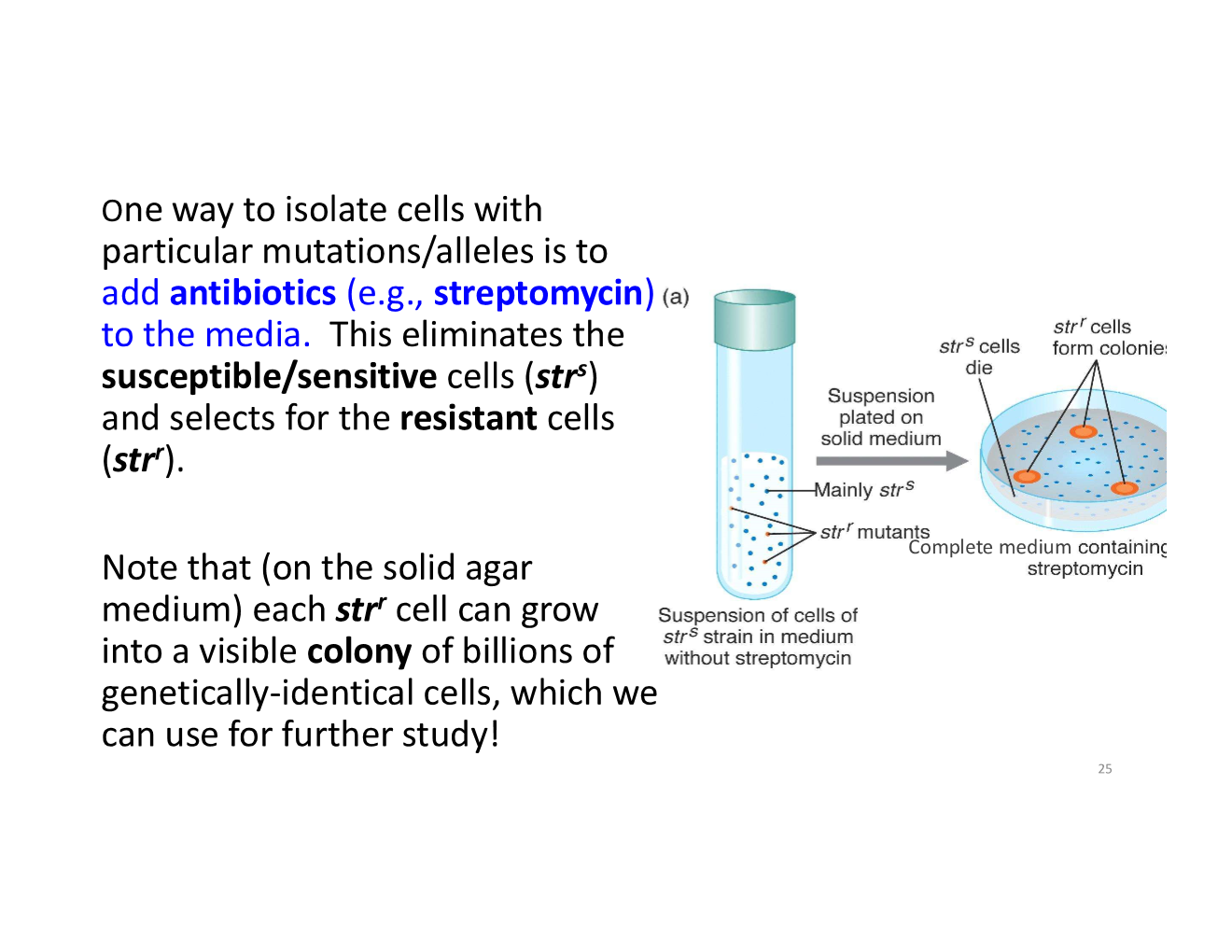
how can we use selection systems for genetic engineering?
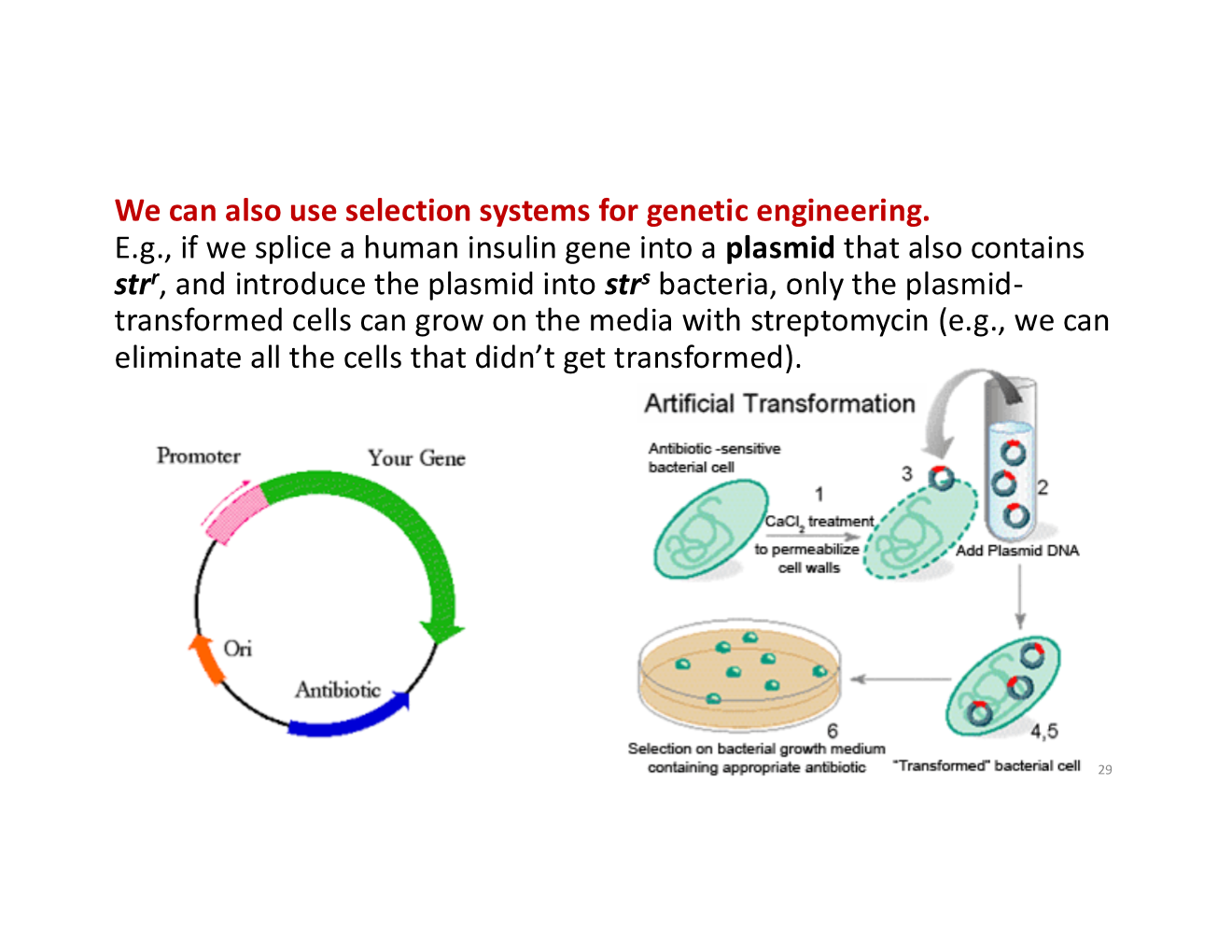
selectable markers
alleles you can select for, using different conditions
common selectable markers
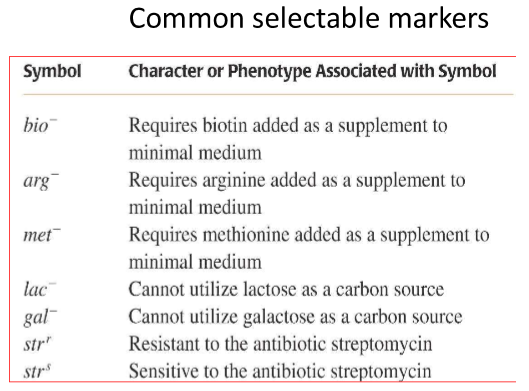
bio-, arg-, and met-
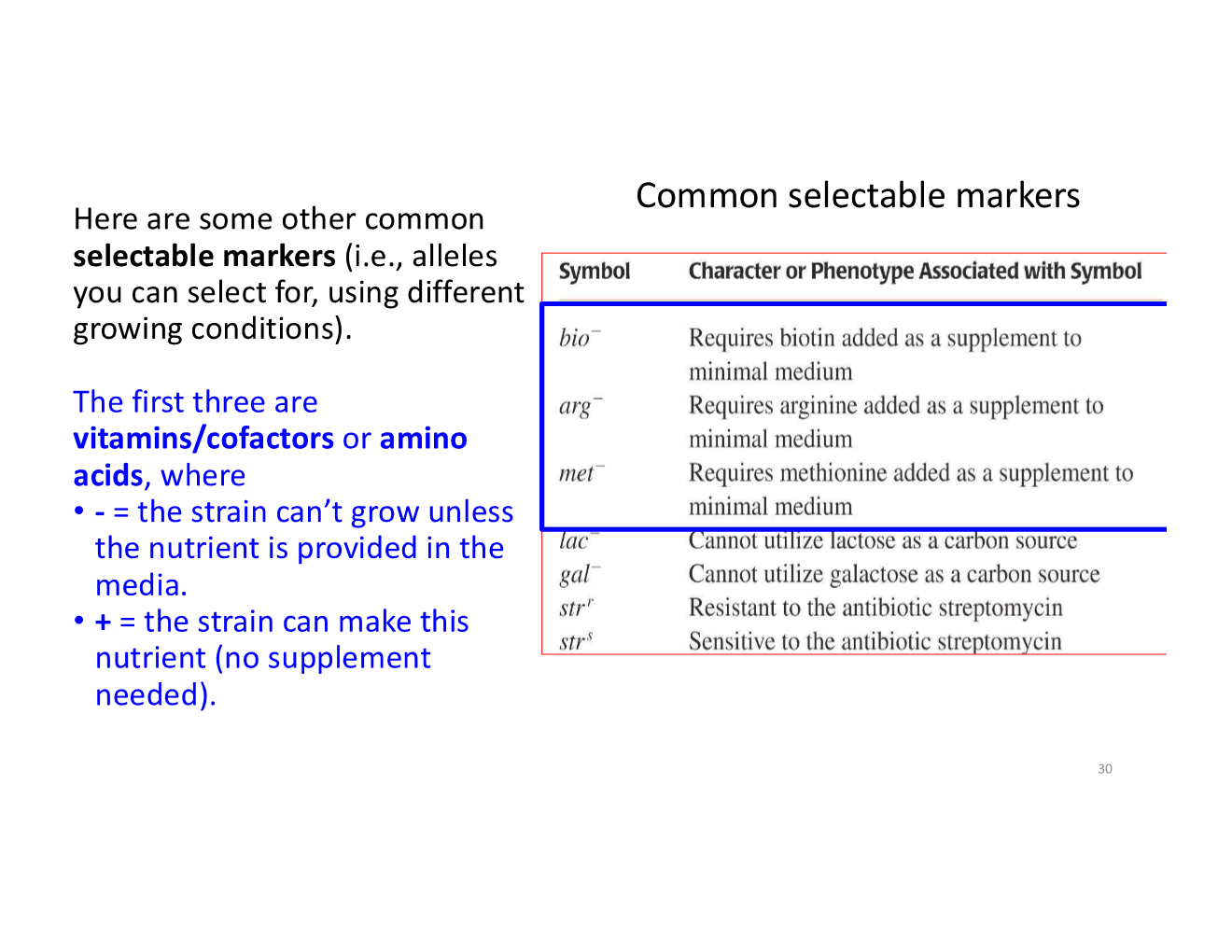
lac- and gal-
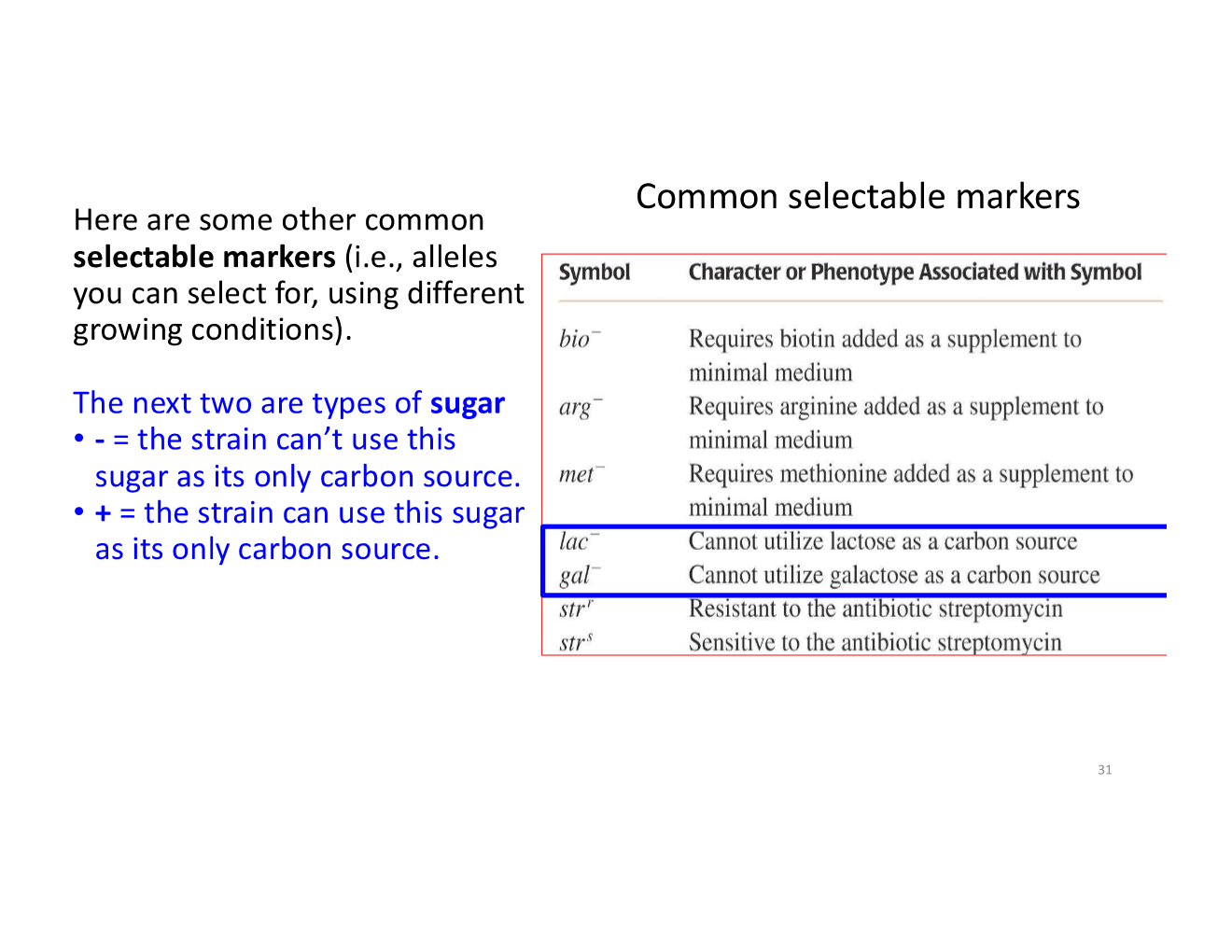
strr and strs
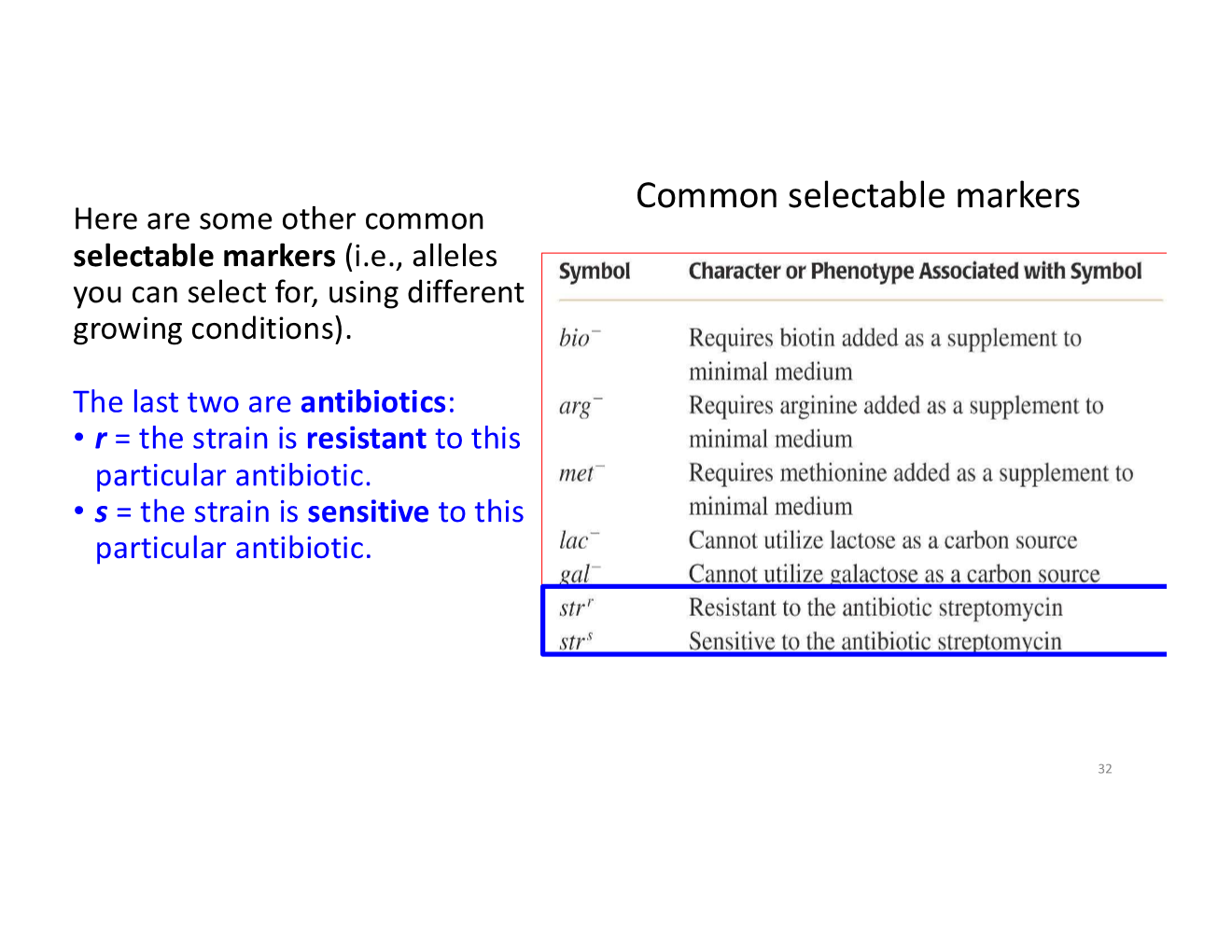
nature of conjugation

if the donor cell is not labelled F+ :
it cannot recognize the other cell
it cannot create a pilus
it cannot give away their genetic material
F plasmid
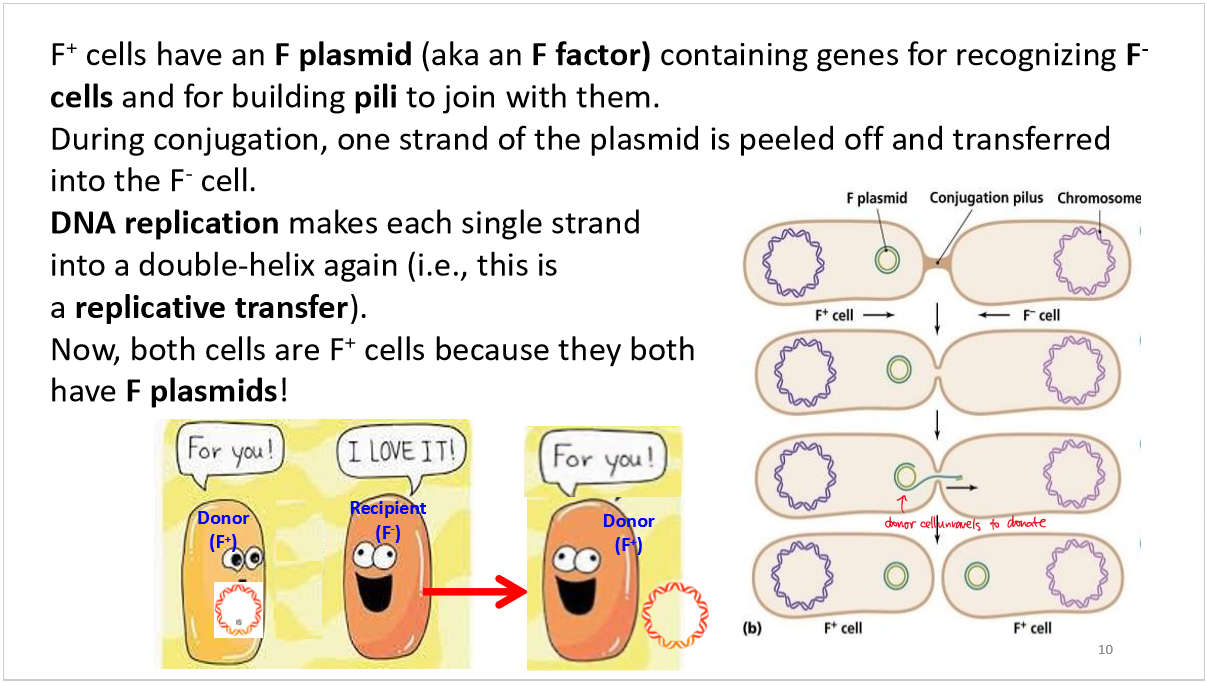
how is the F plasmid transferred and replicated during bacterial conjugation?
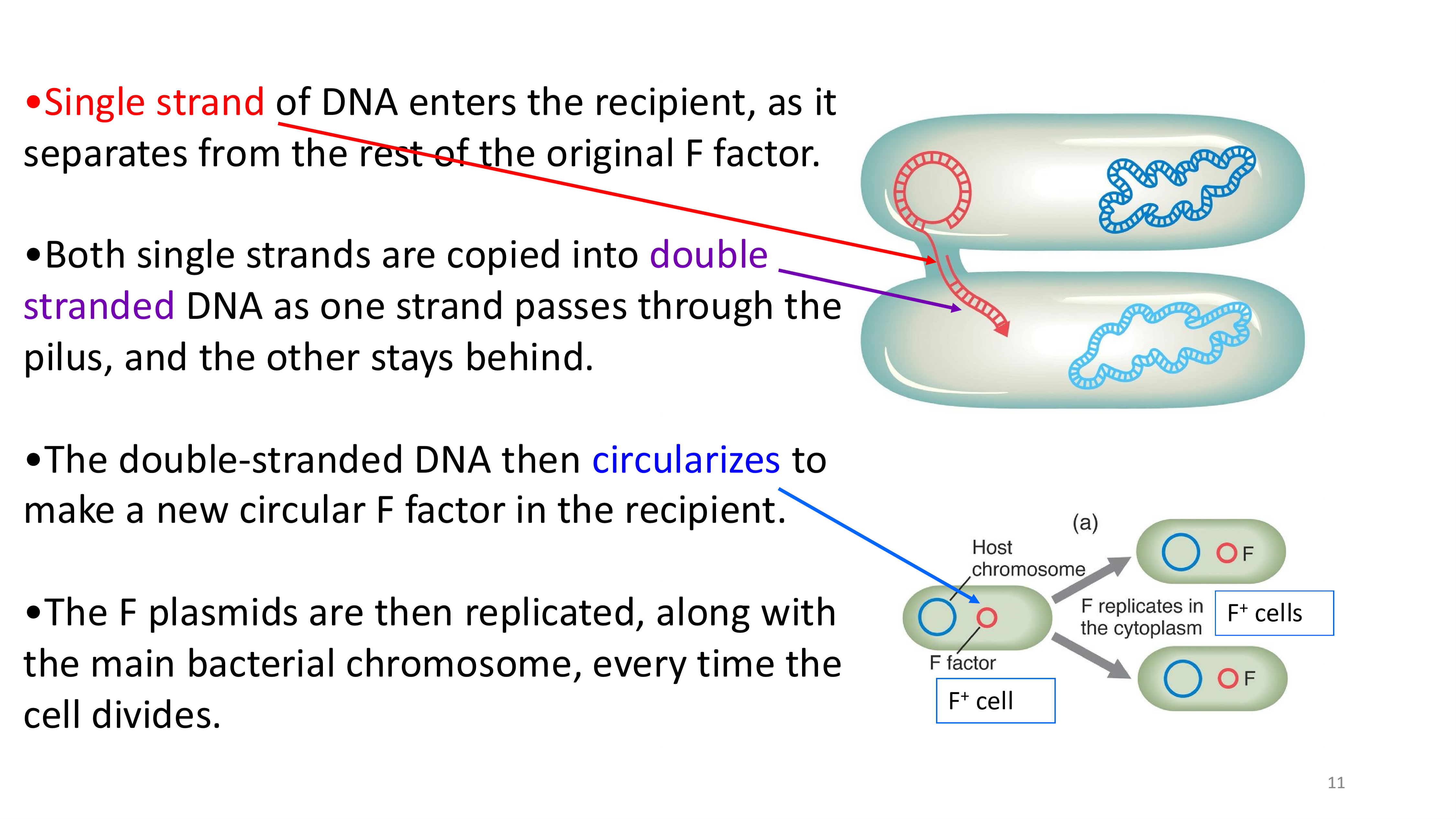
what happens when the F factors is integrated into the bacterial chromosome?
the F+ cell becomes an Hfr (high frequency recombination) cell
can Hfr cells still donate DNA to F-/recipient cells?
yes, because Hfr cells still have the F plasmid’s genes for forming pili and donating genes (e.g., same genes, just different arrangement)
are Hfr cells more or less likely to donate chromosomal genes to recipient cells, when compared to F+ cells?
1000x more likely
OriT
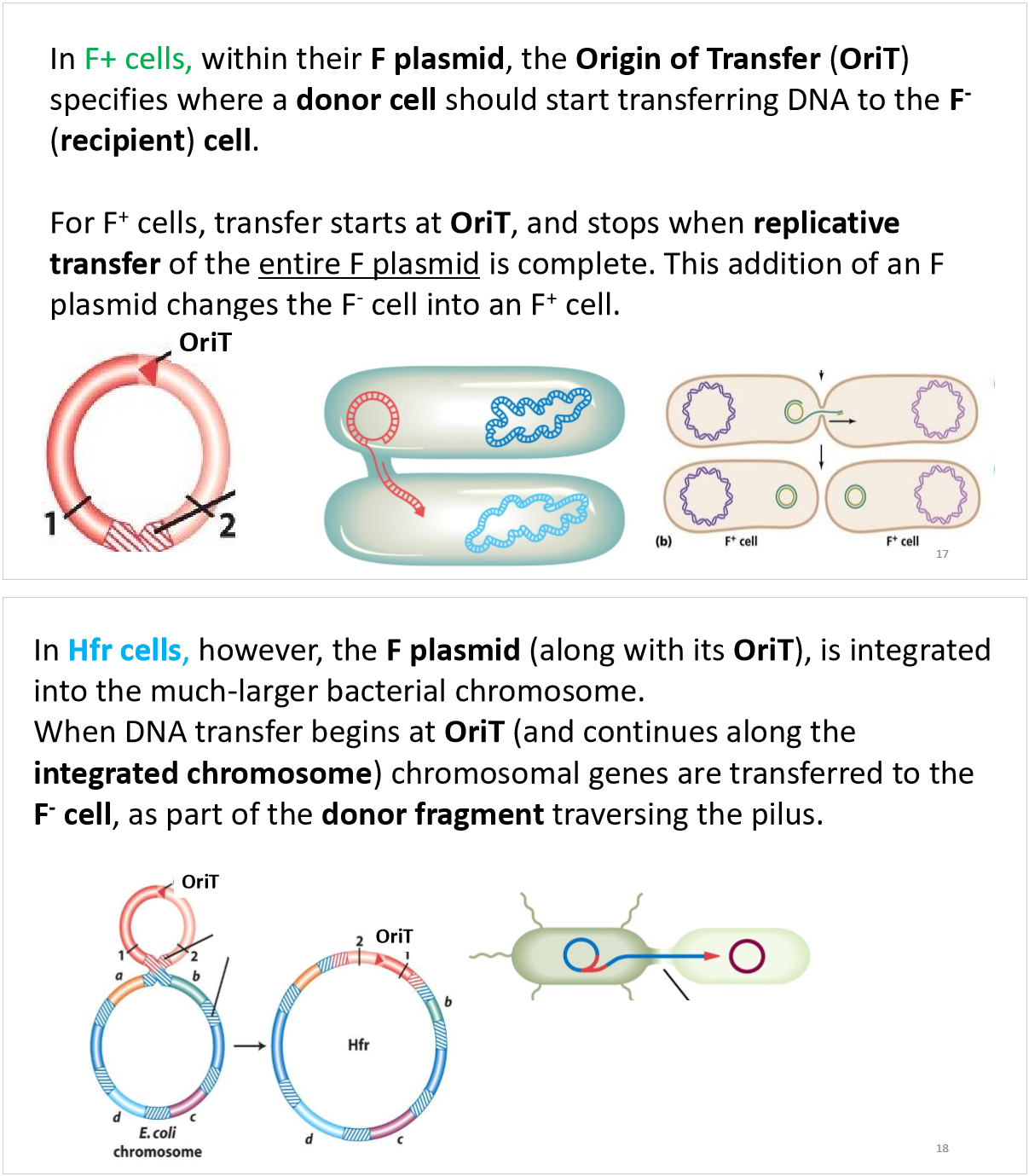
crude mapping using interrupted conjugation
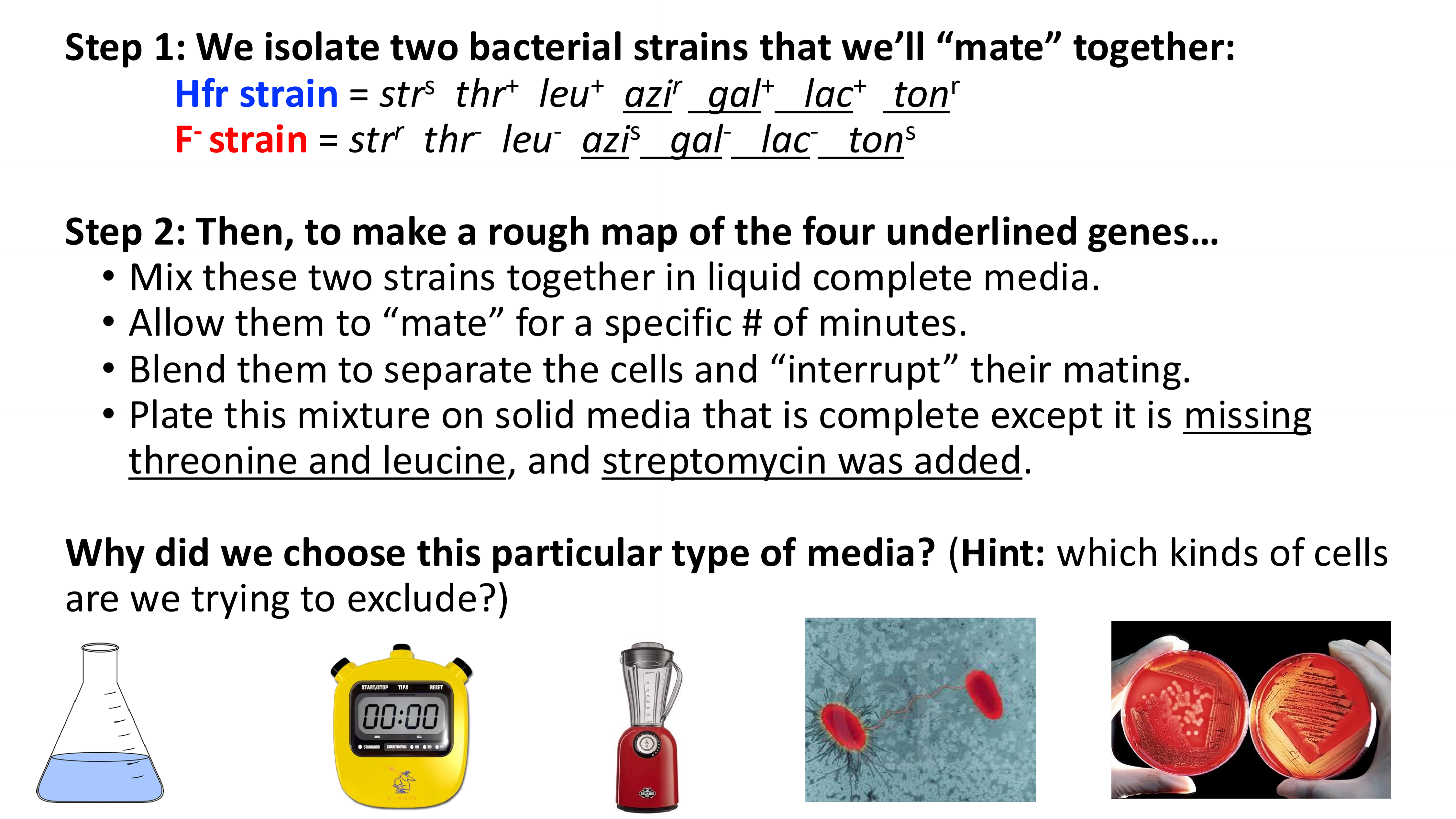
crude gene mapping using “interrupted mating” experiments summary
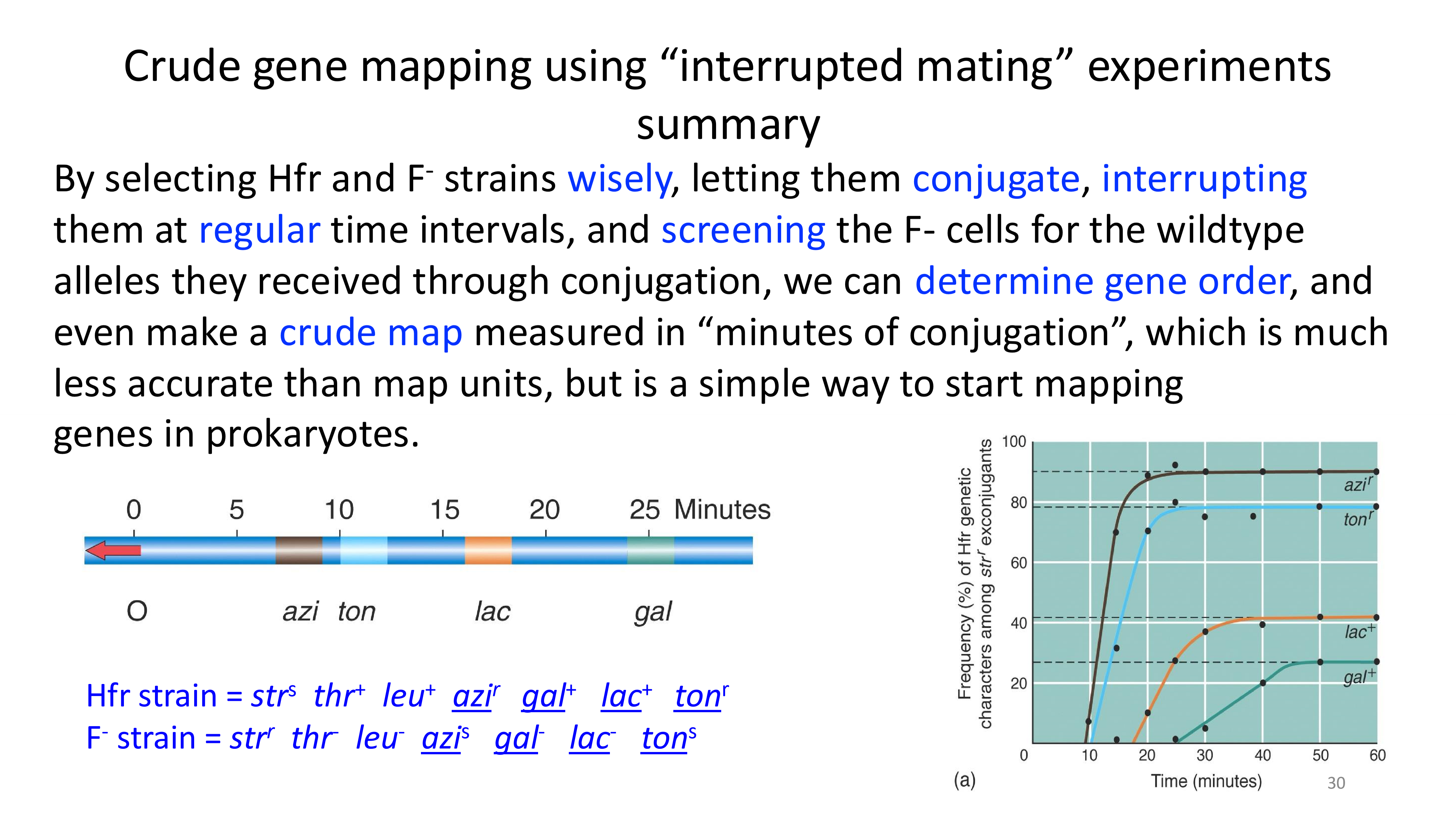
what is the problem with mapping a prokaryote’s genome
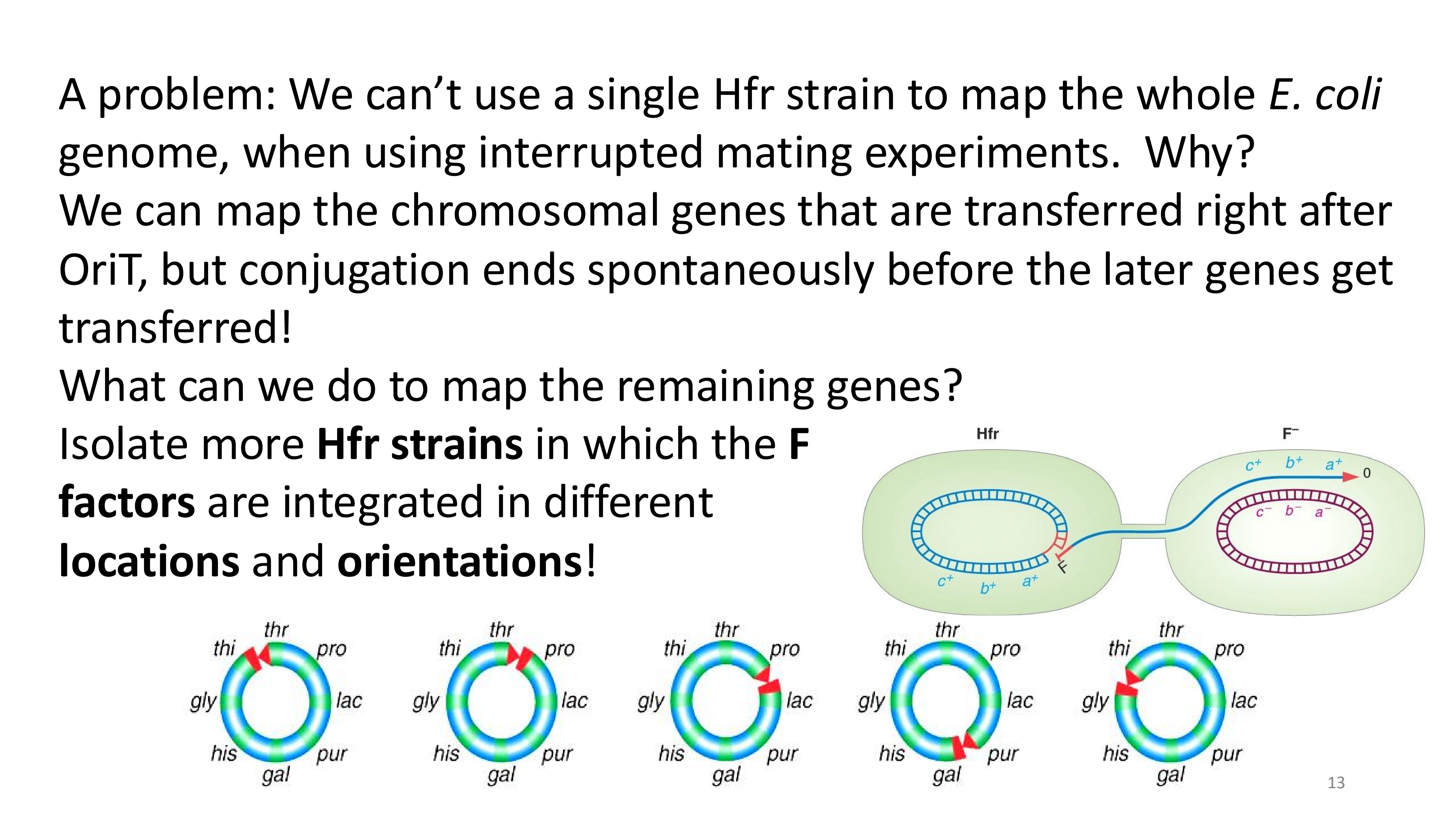
integration when mapping genes
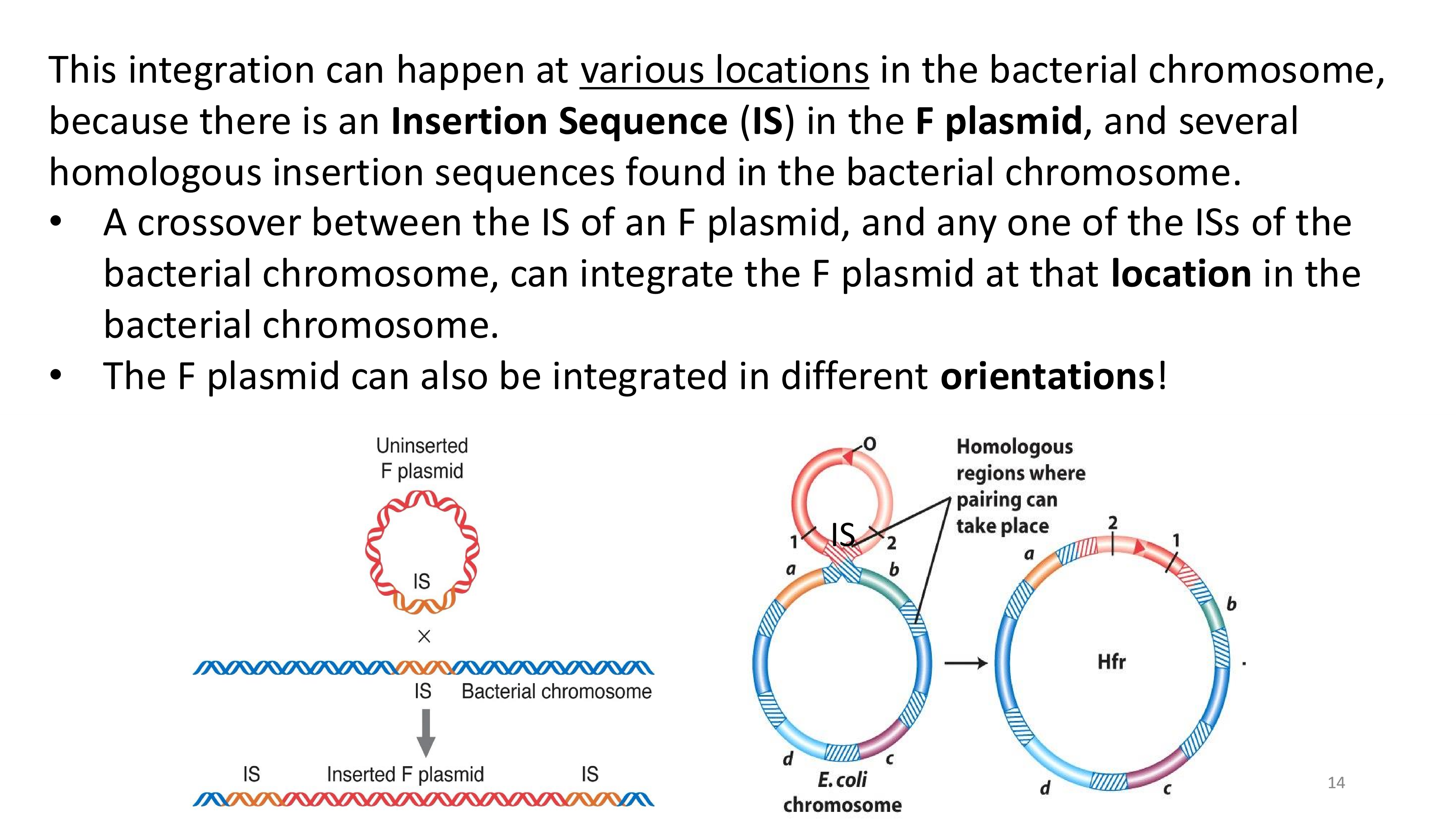
how would we make a complete crude genome map?
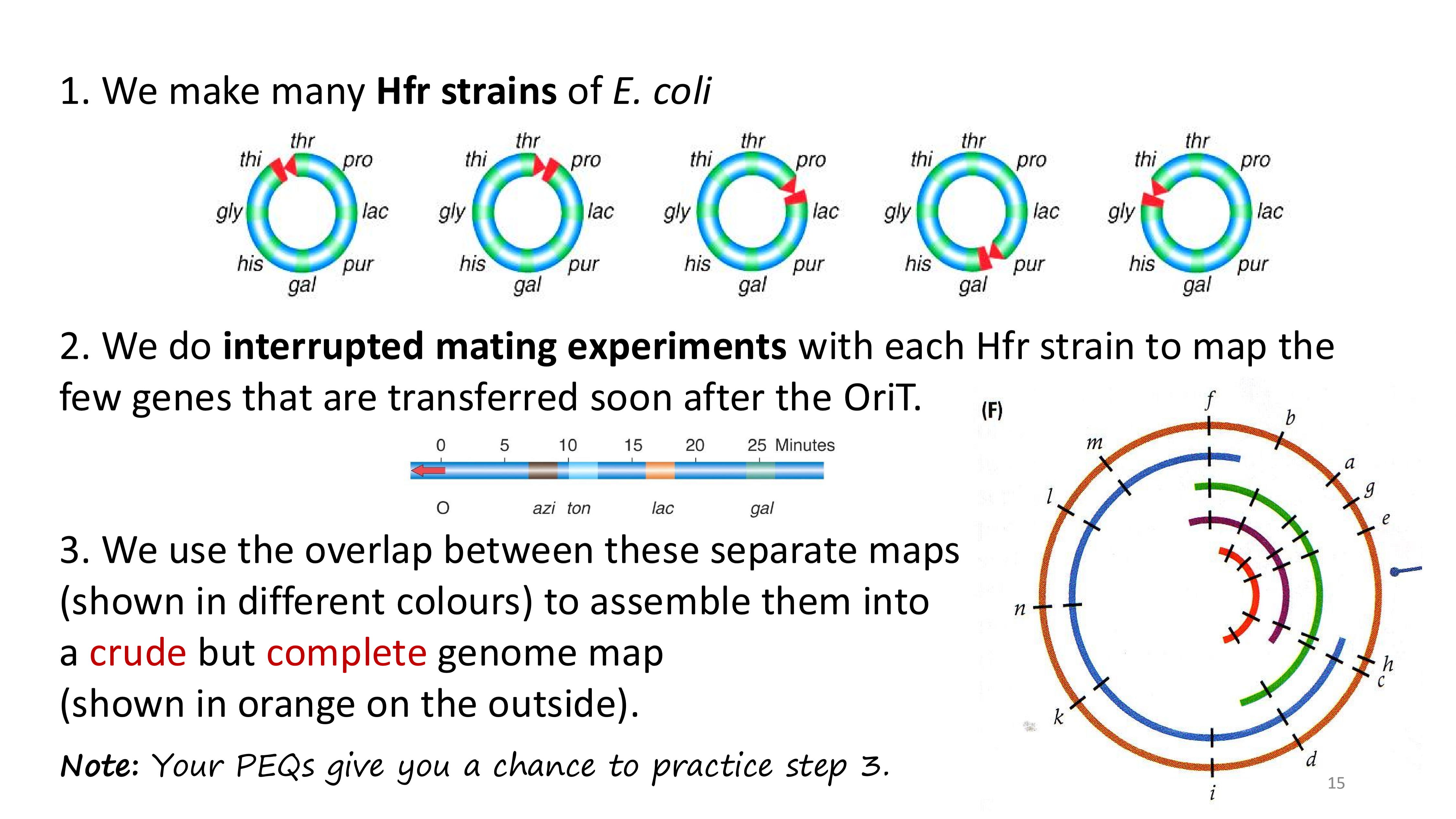
high-resolution mapping with conjugation and recombination frequencies
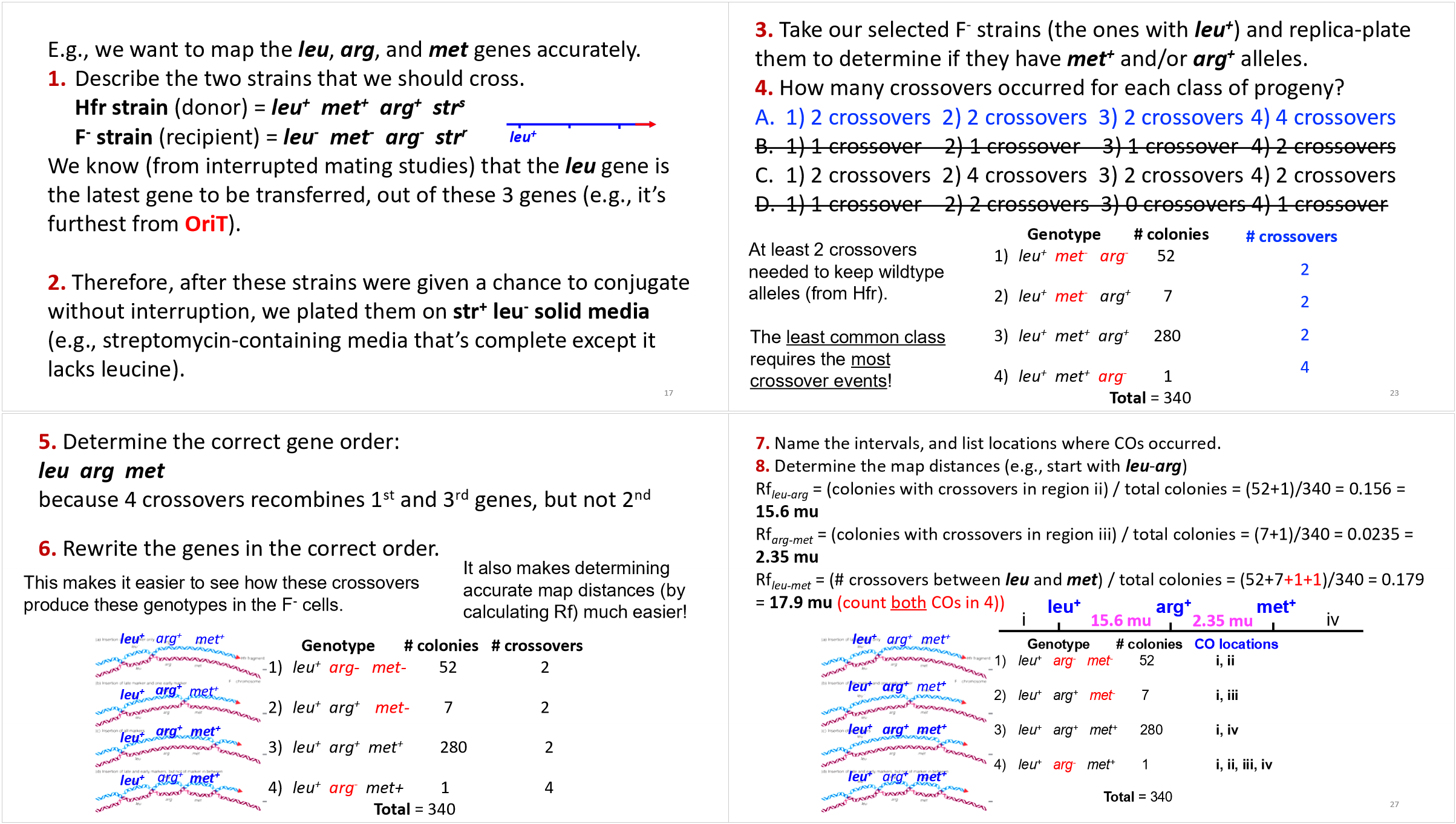
mapping with conjugation vs transformation
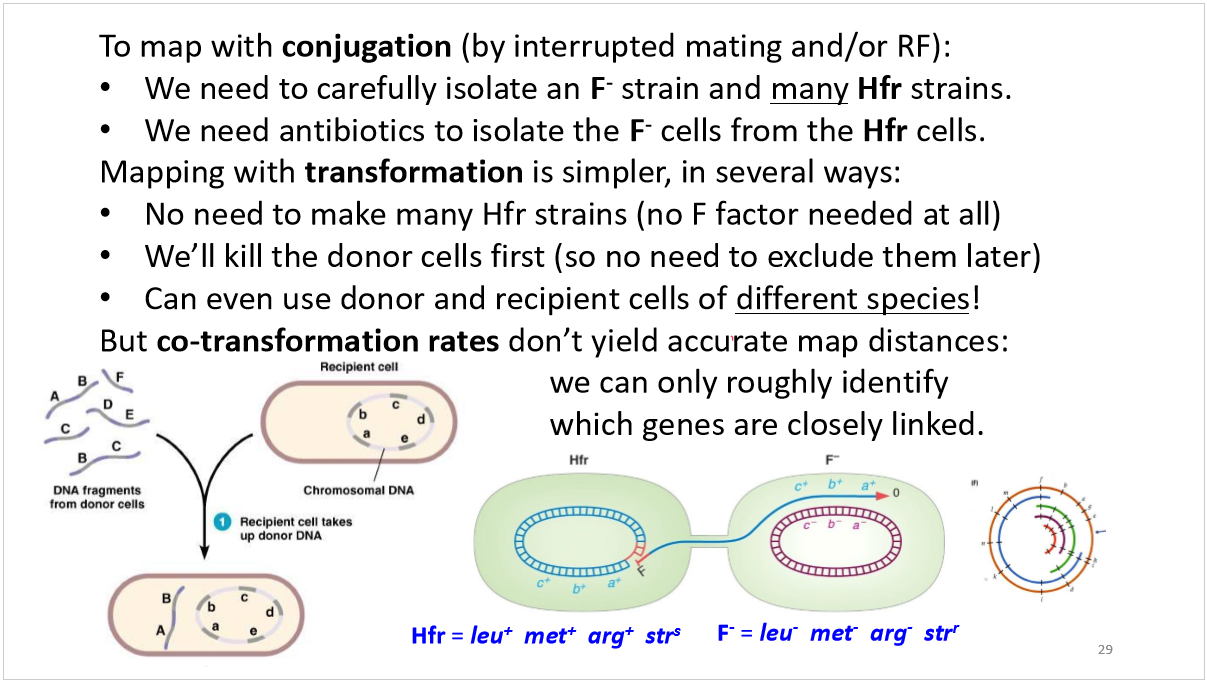
how does transformation work?
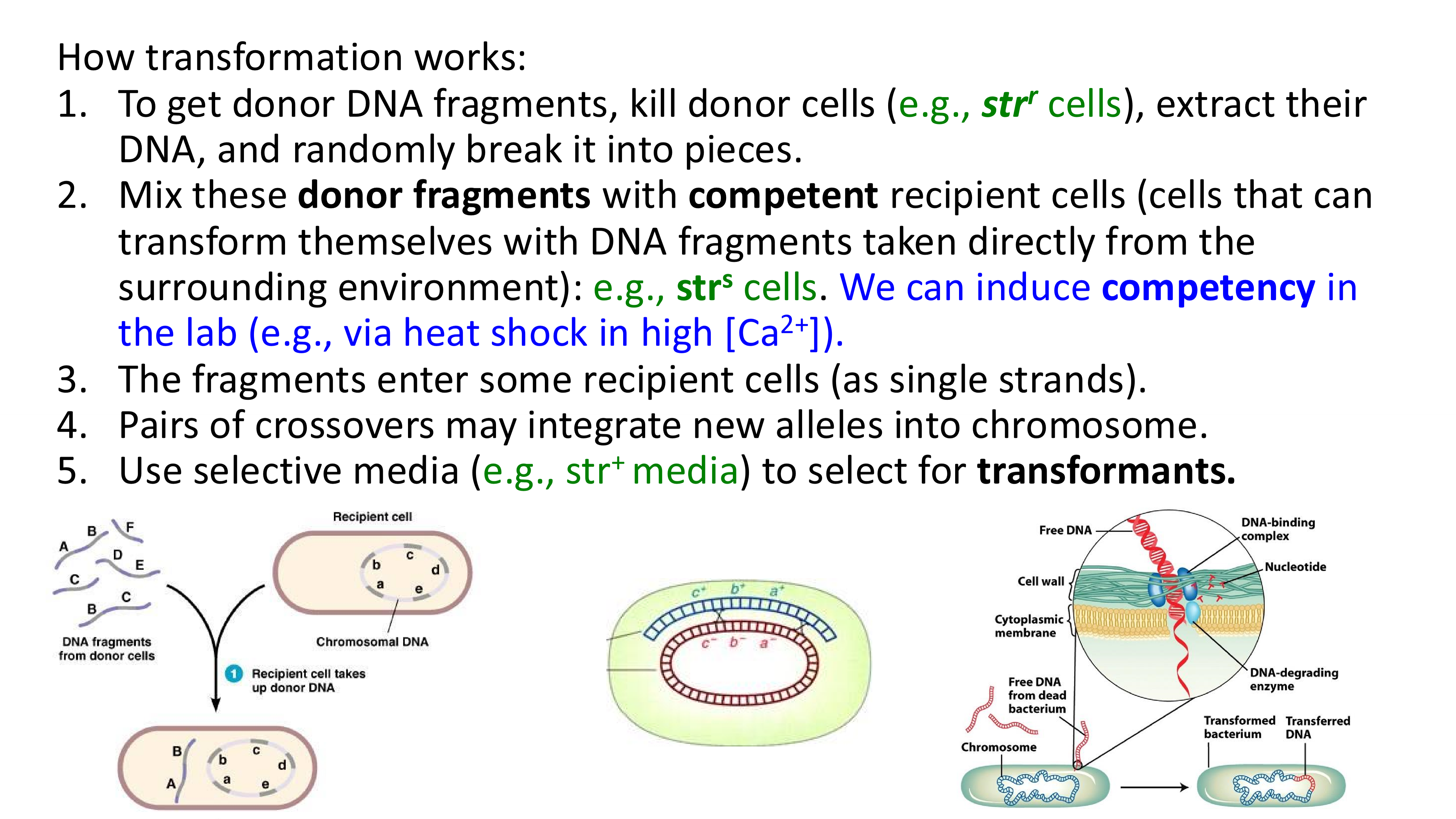
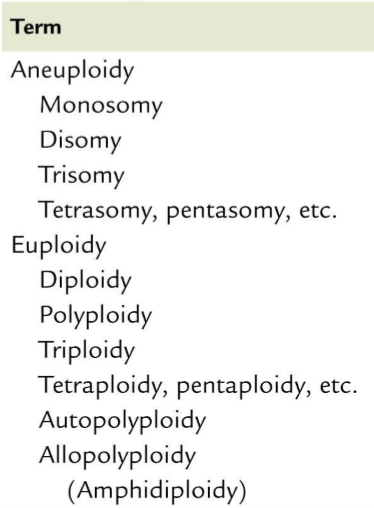
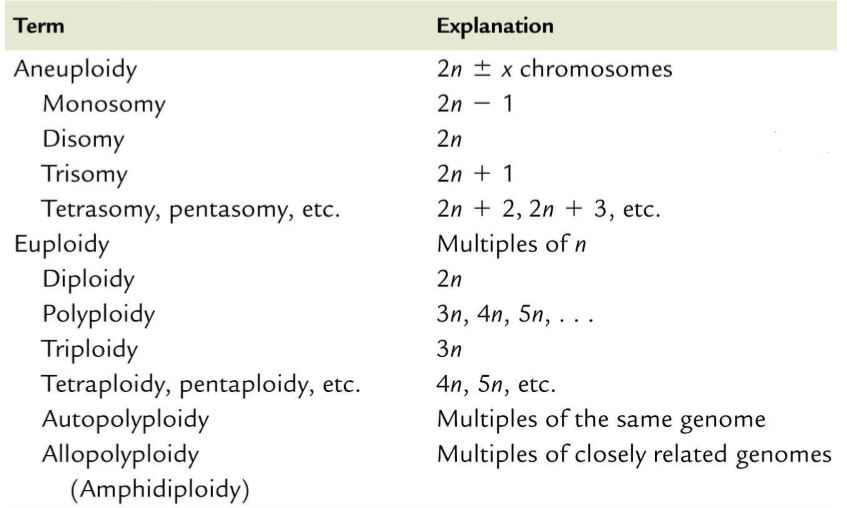
what are the two types of mutations affecting the number of chromosomes?
euploidy and aneuploidy
euploidy

aneuploidy
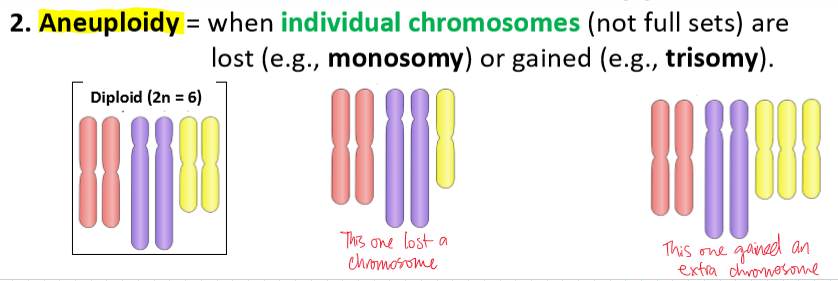
natural causes of monoploidy
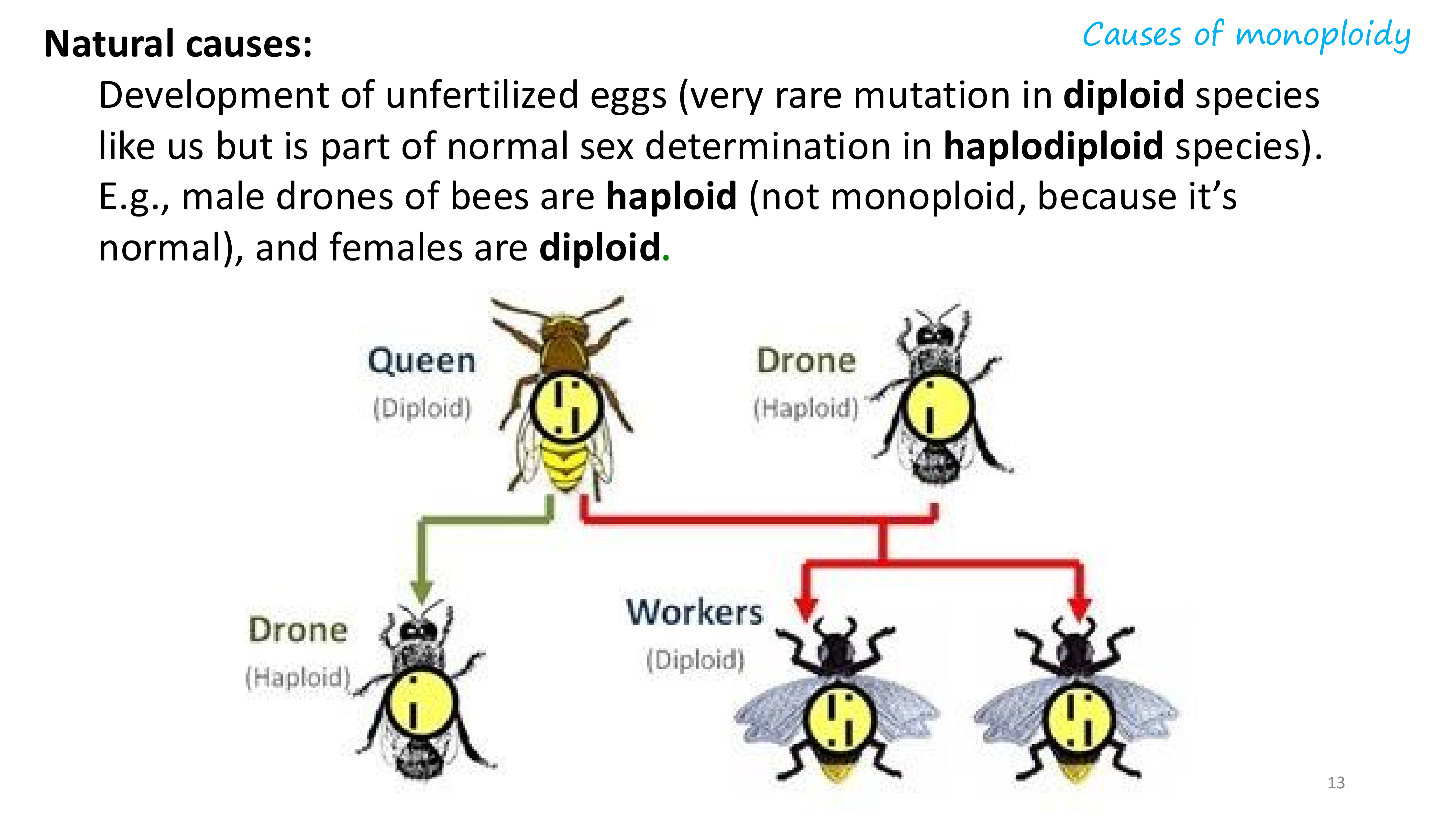
artificial causes of monoploidy
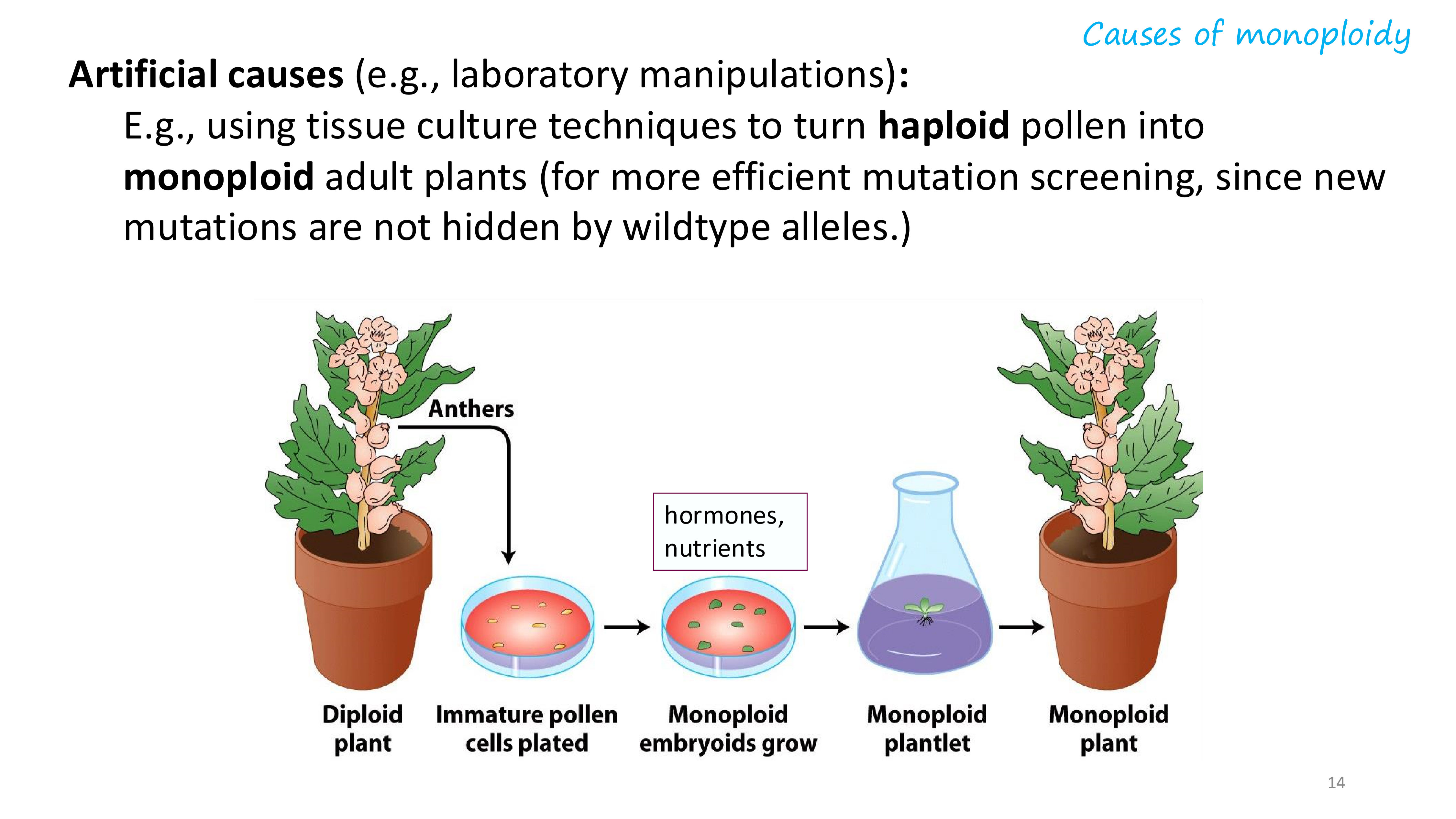
effects of monoploidy on survival and phenotype
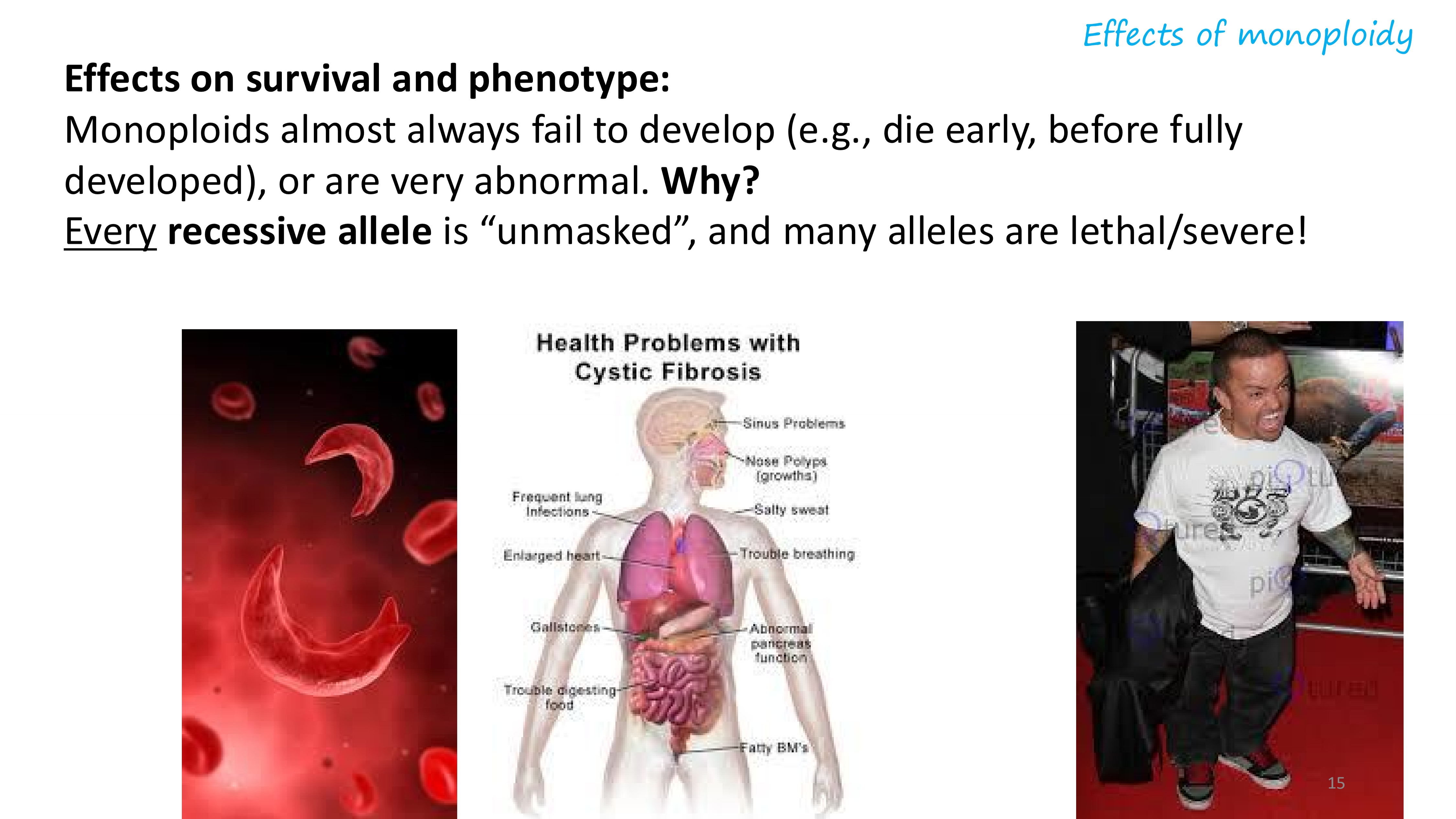
effects of monoploidy on reproduction

why are monoploids almost always sterile
unless the gamete is lucky enough to get every chromosome (during meiosis I) it will be missing one or more chromosomes, and the resulting offspring will usually not survive
which events can contribute to the formation of a tetraploid cell?

how do tetraploids compare to normal diploids, in plants?
tetraploids are fertile and have larger size/yields
types of polyploidy with >2n
autopolyploid and allo(amphi)polyploid
autopolyploid
a polyploid created by the multiplication of one basic set of chromosomes (in one species)
allo(amphi)polyploid
an individual that has 2 or more sets of genetically distinct chromosomes, made by hybridization of two different species
effects of allopolyploidy examples

allotetraploid
mix of the DNA of two different species
triploidy
when the odd number of chromosome sets (one extra set of chromosomes as in 3n) is present
how would you make triploid plant?
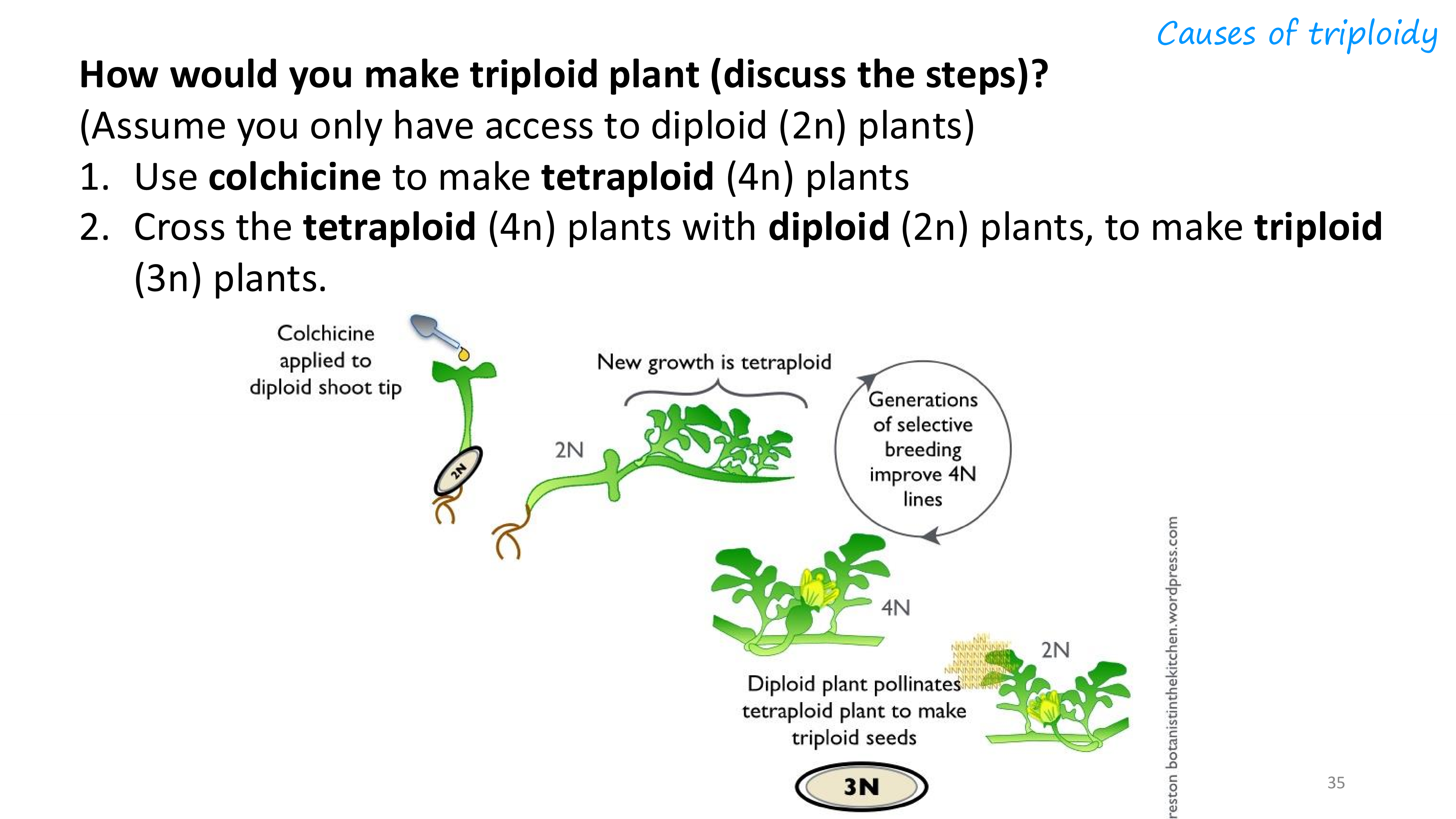
why would agricultural scientists make a triploid plant?
the triploid plant can be hardier and have higher yield than the diploid plants
triploid plants are sterile and can’t make viable offspring
imagine we took a diploid plant species and made a monoploid, an autotriploid, and an autotetraploid
order them from lowest to highest Darwinian fitness, if released in the wild
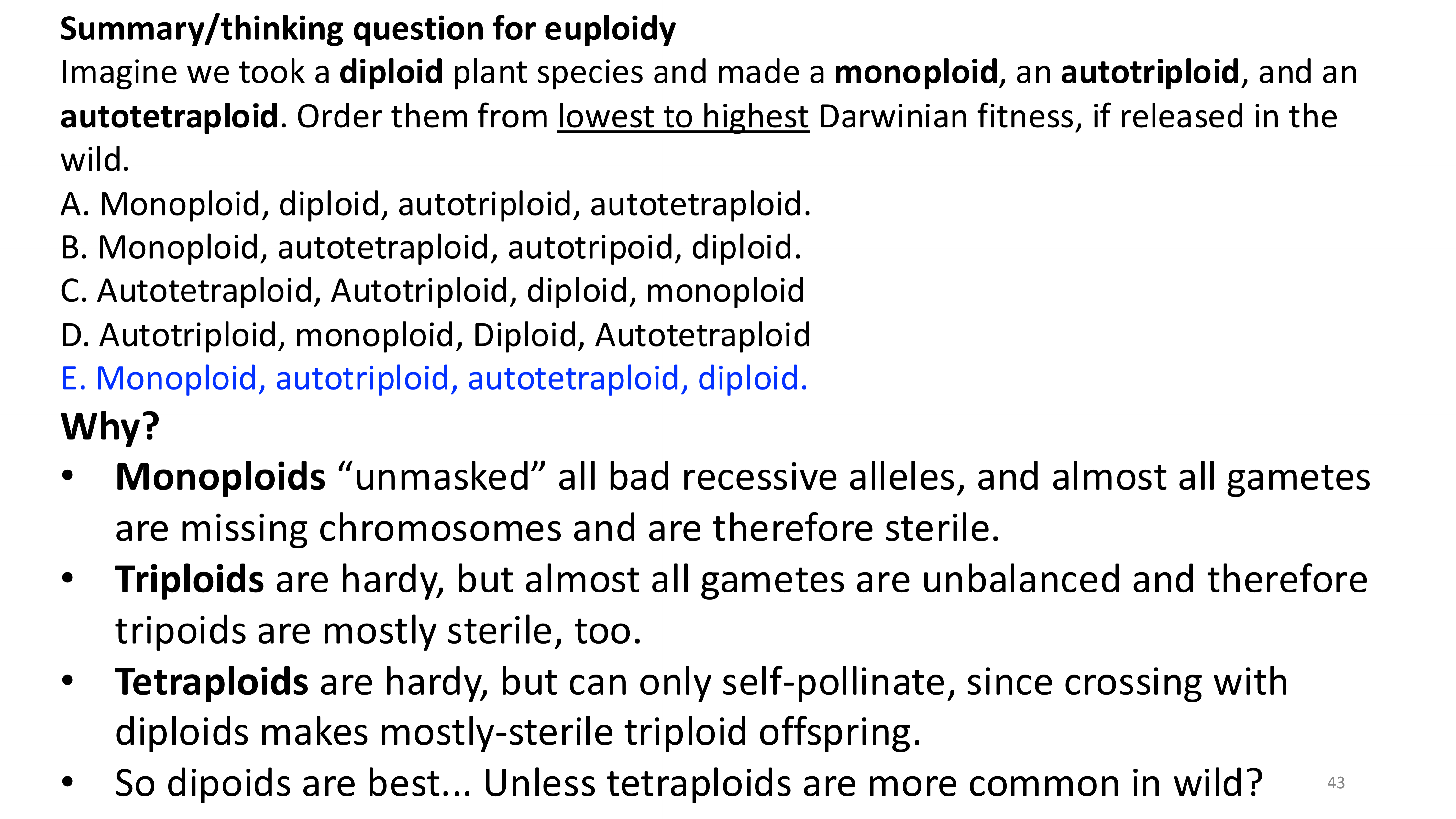

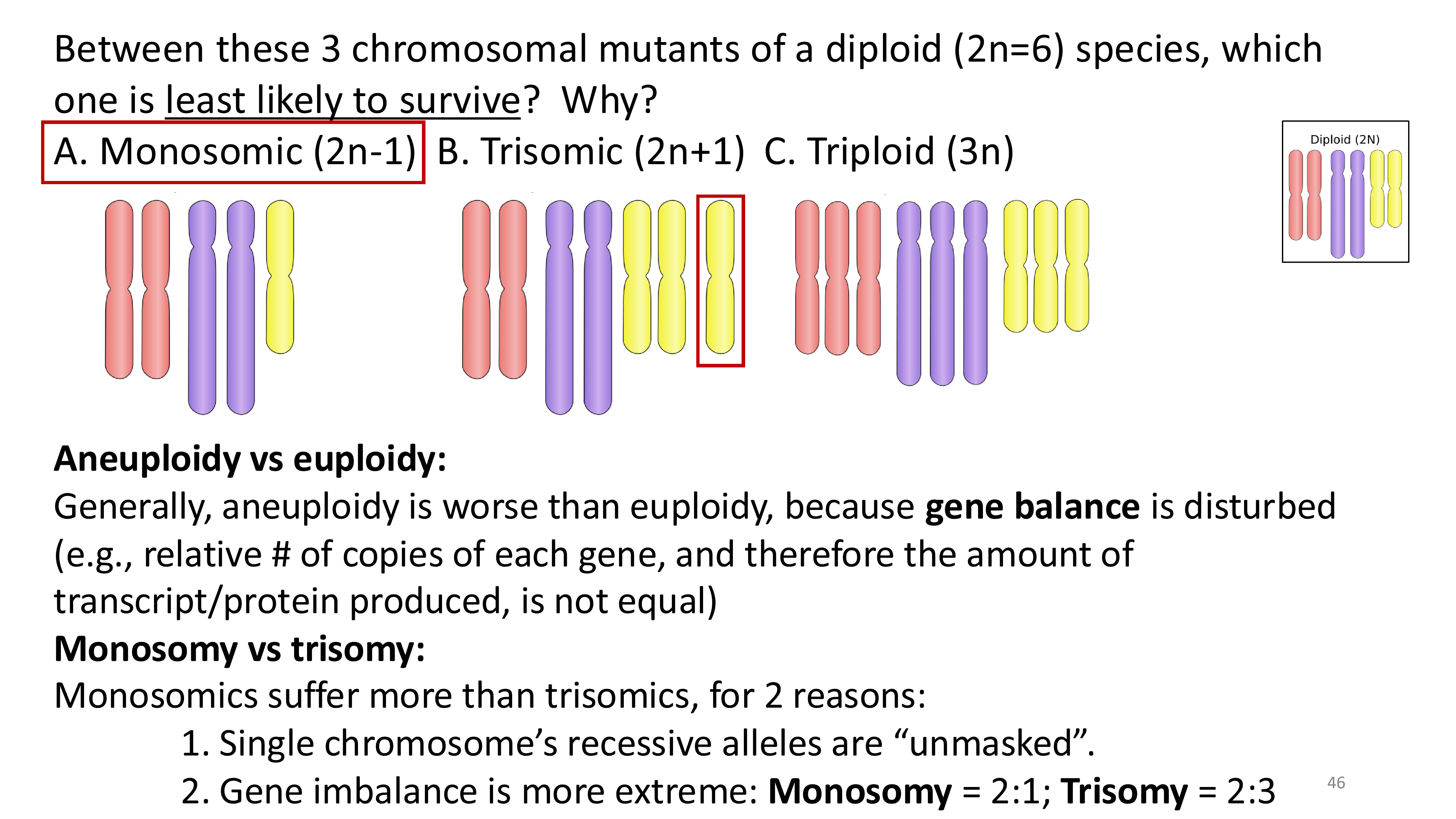
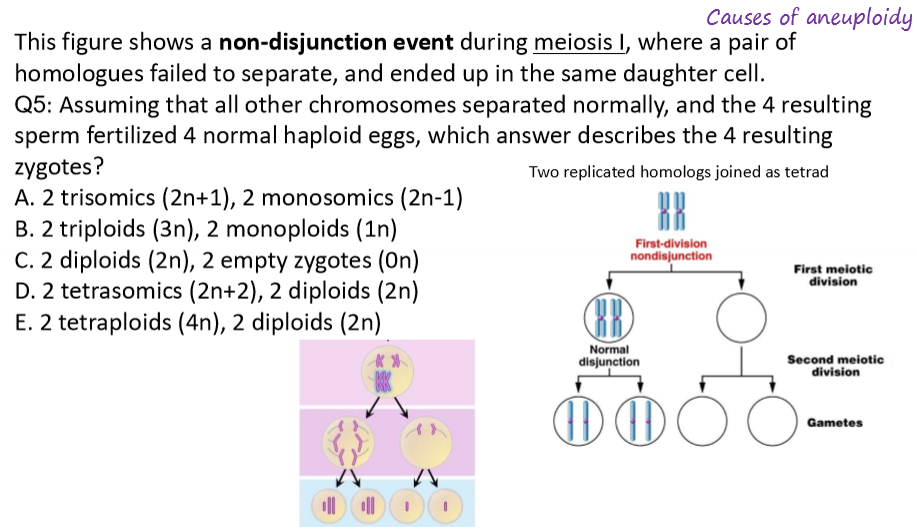
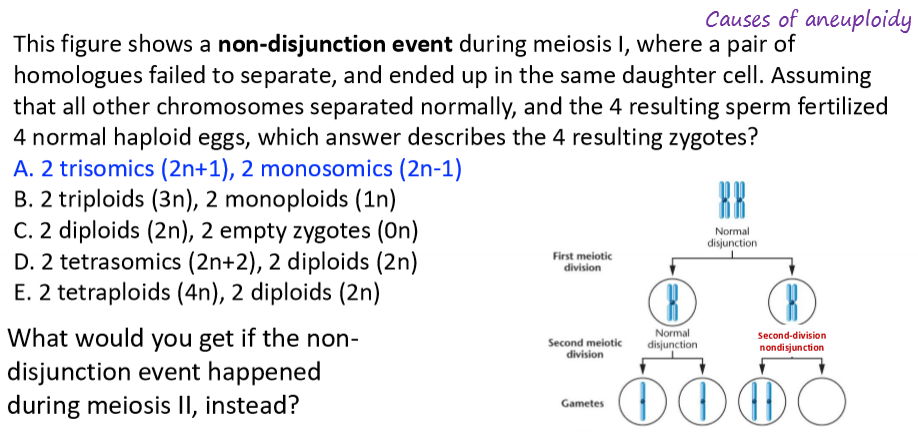
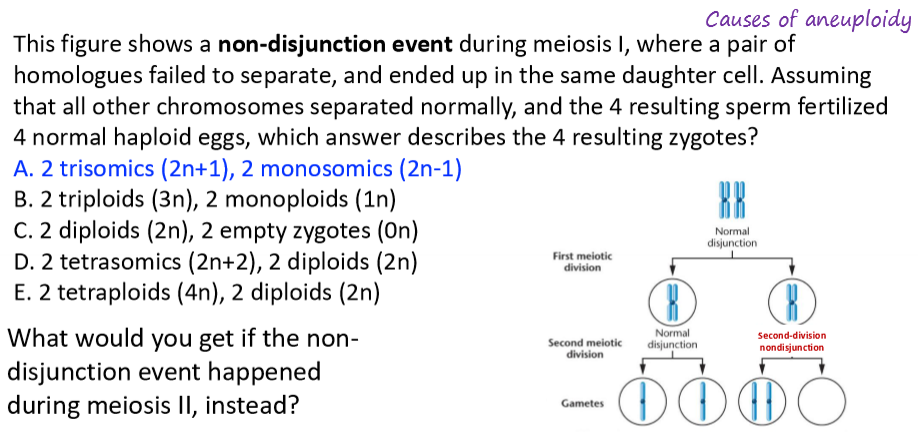
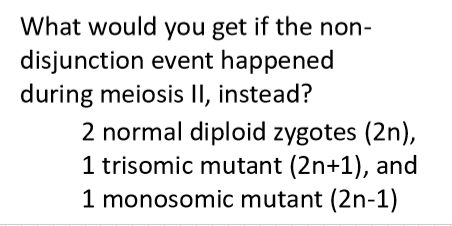
why do non-disjunction events happen?
before birth, oocytes are all formed, and arrested in meiosis I. Meiosis resumes for each oocyte just before ovulation…decades later
if a microtubule breaks/detaches during that wait, non-disjunction occurs and aneuploidy is seen in offspring
Down syndrome is caused by trisomy 21, but why don’t we hear more about monosomy 21, or other trisomies and monosomies?
most of the other aneuploids don’t survive long enough to be born
most animals have a very delicate gene balance and many recessive lethal alleles, so most aneuploids are lost before birth
chromosome 21’s small size and gene compliment is why people with trisomy 21 are more likely to survive
for which chromosome pair is aneuploidy less lethal?
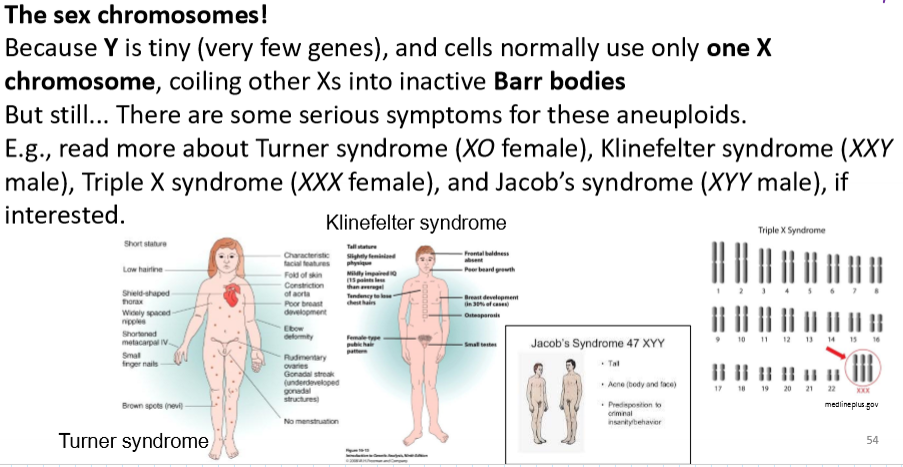
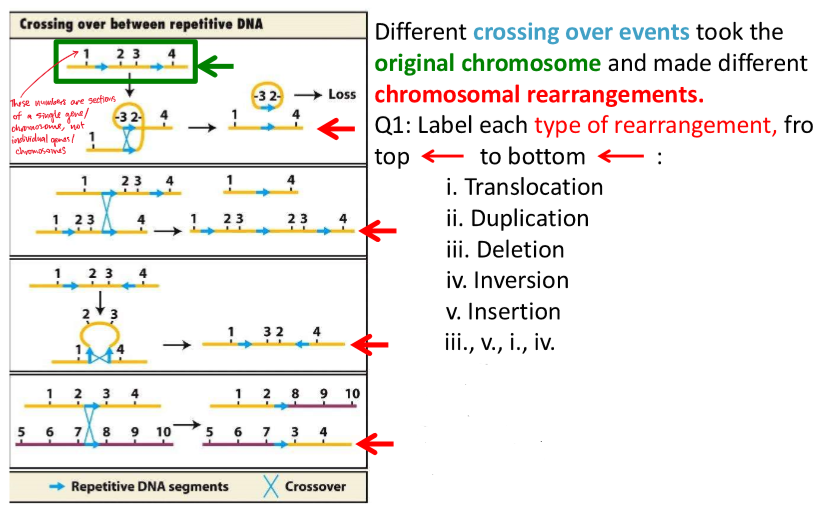
iii., ii., iv., i.
deletions
when a portion of DNA is lost from the chromosome (e.g., 2 and 3)
note: the numbers indicate major chromosomal segments that each contain many genes
what can deletions be caused by?
these chromosomes are homologous
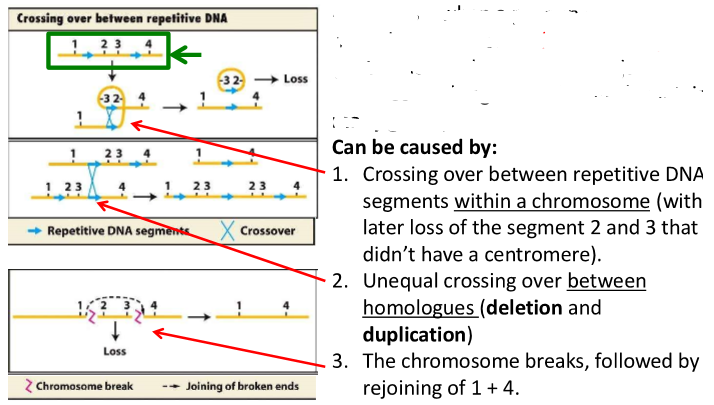
duplication
when a portion of DNA is present more than once in a chromosome
what can duplications be caused by?
these chromosomes are homologous
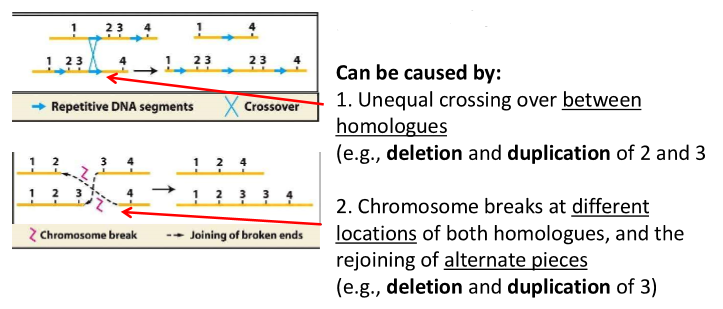
inversion
when a portion of DNA is turned around 180 degrees, within a chromosome
e.g., inversion of 2 and 3
what can inversion be caused by?
these chromosomes are homologous

translocation
when a portion of DNA is moved from one chromosome to another
reciprocal translation is when DNA segments are swapped, and no DNA is lost
what can translocation be caused by?
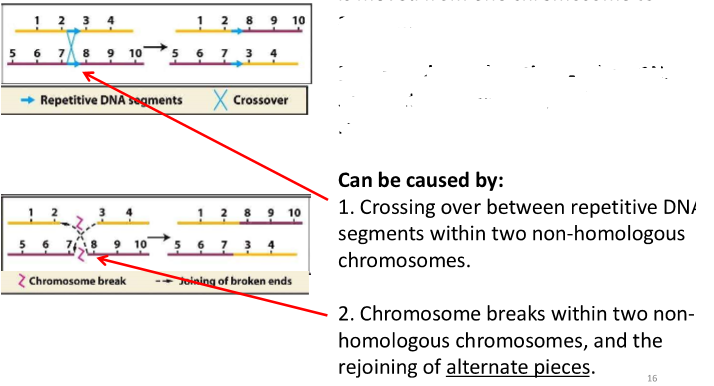
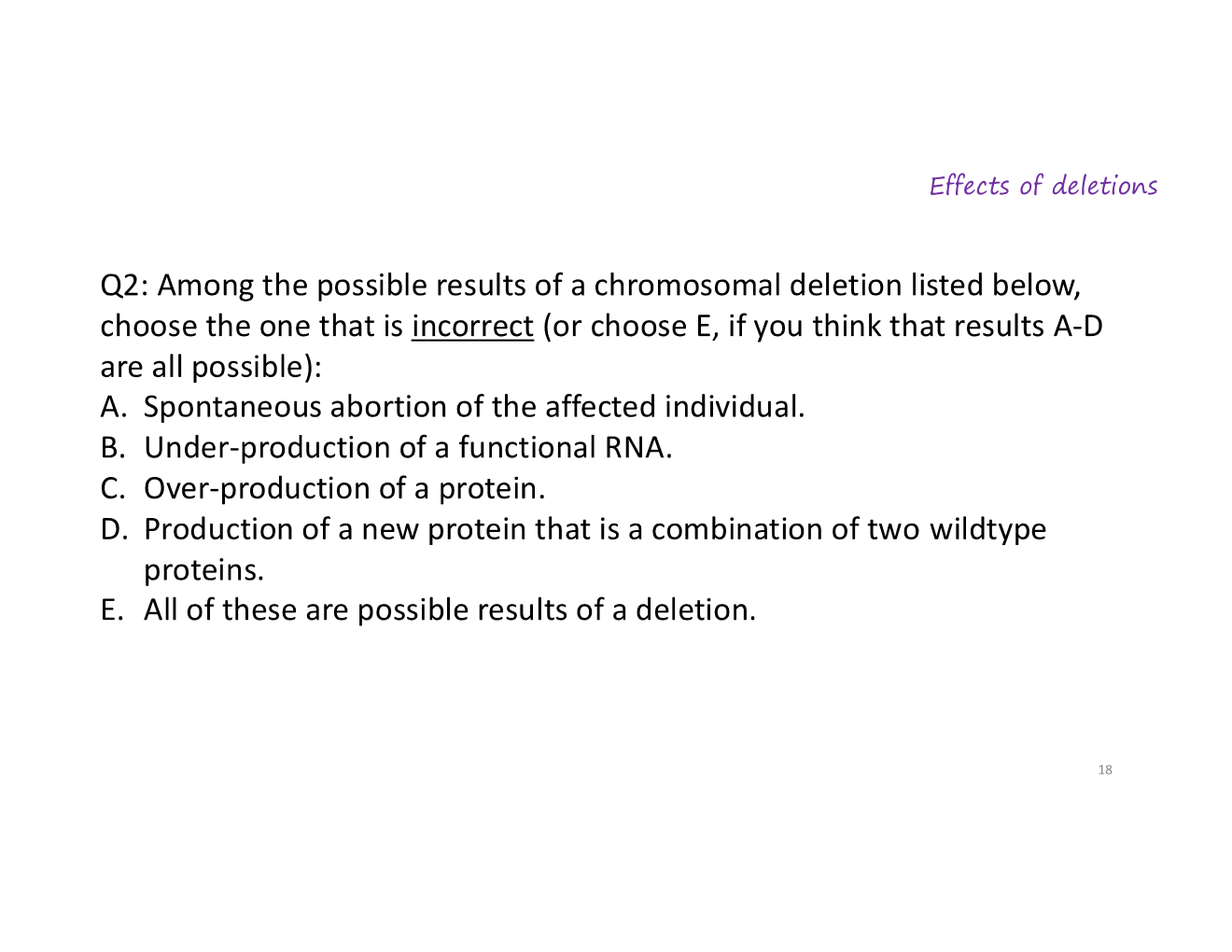
E
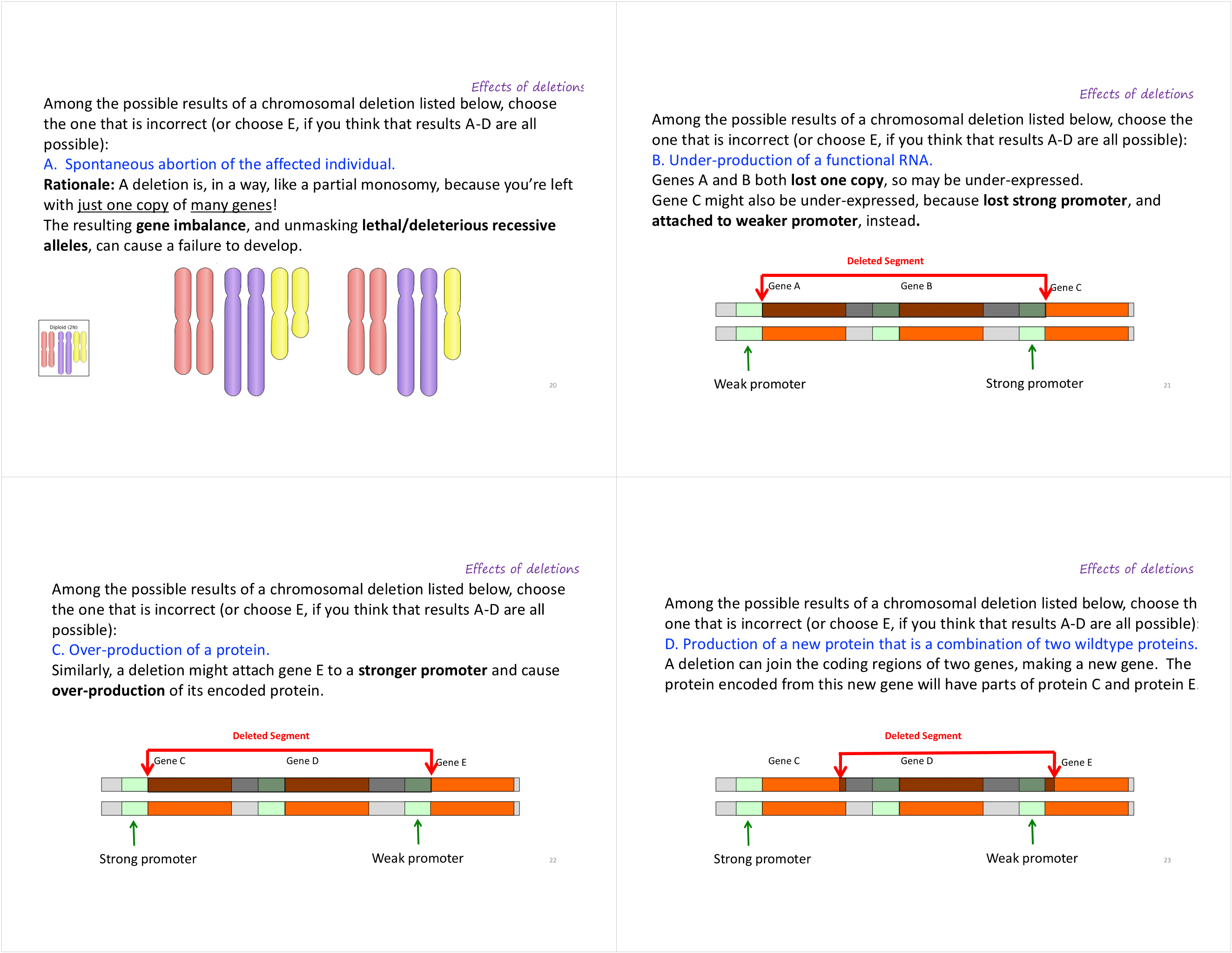
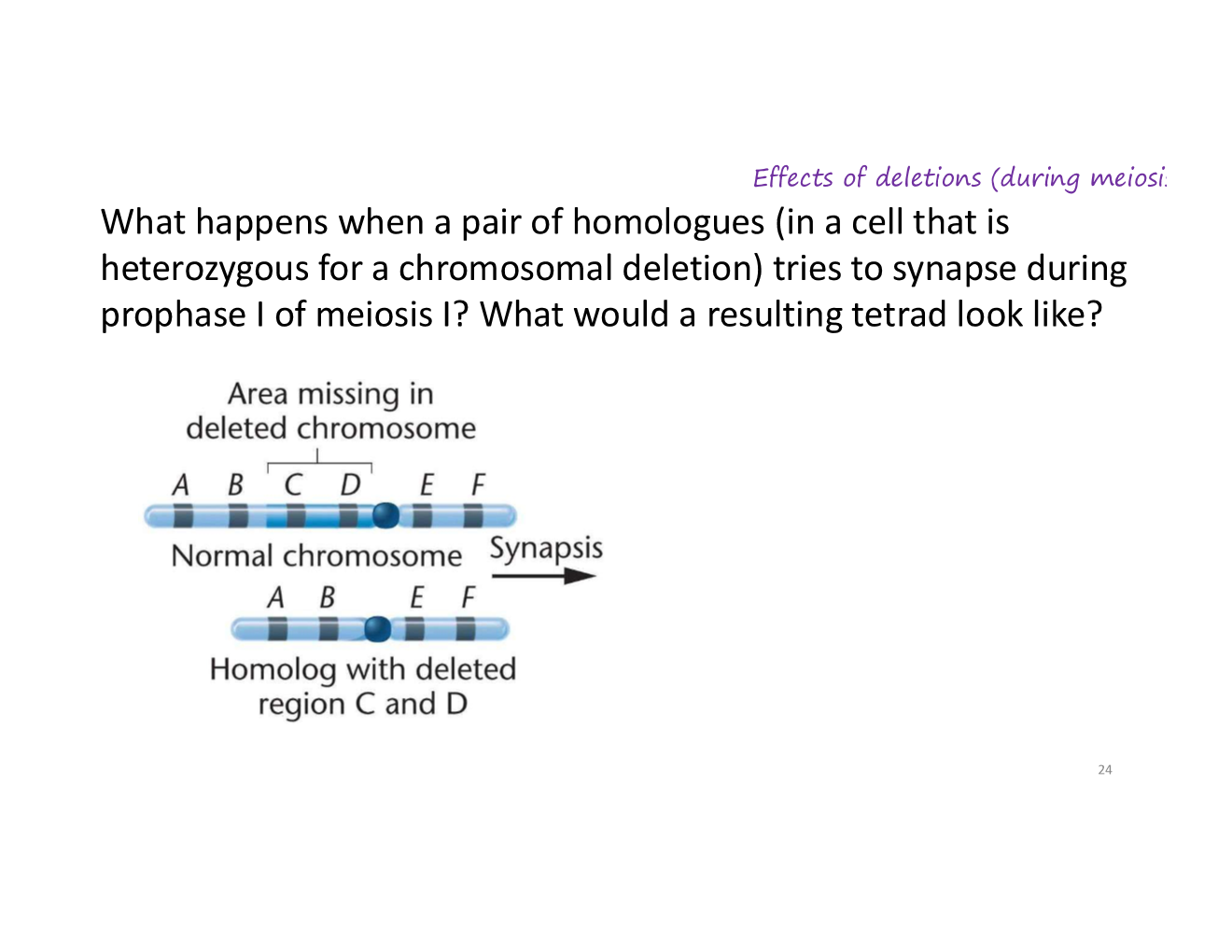
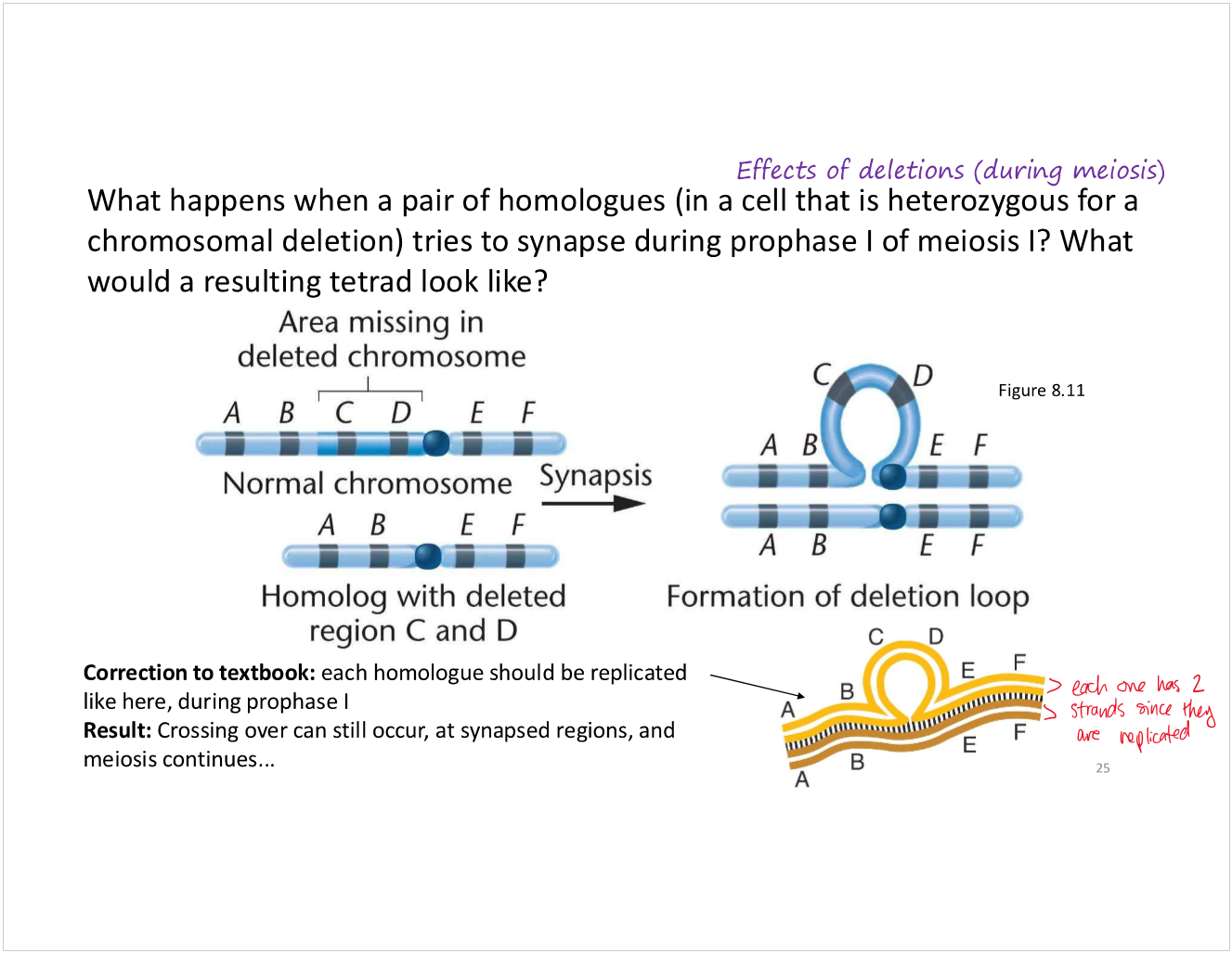
effects of duplications
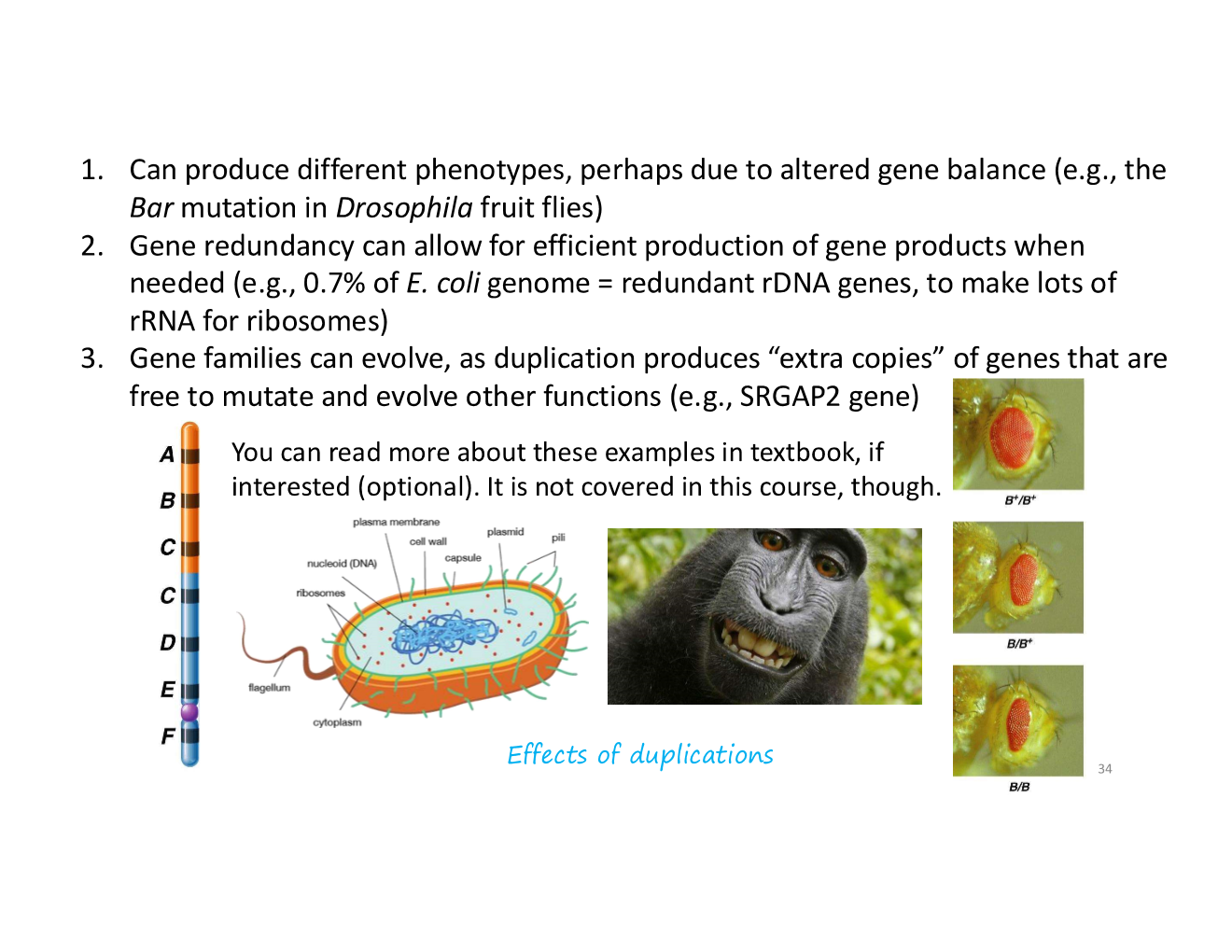
inversions summary
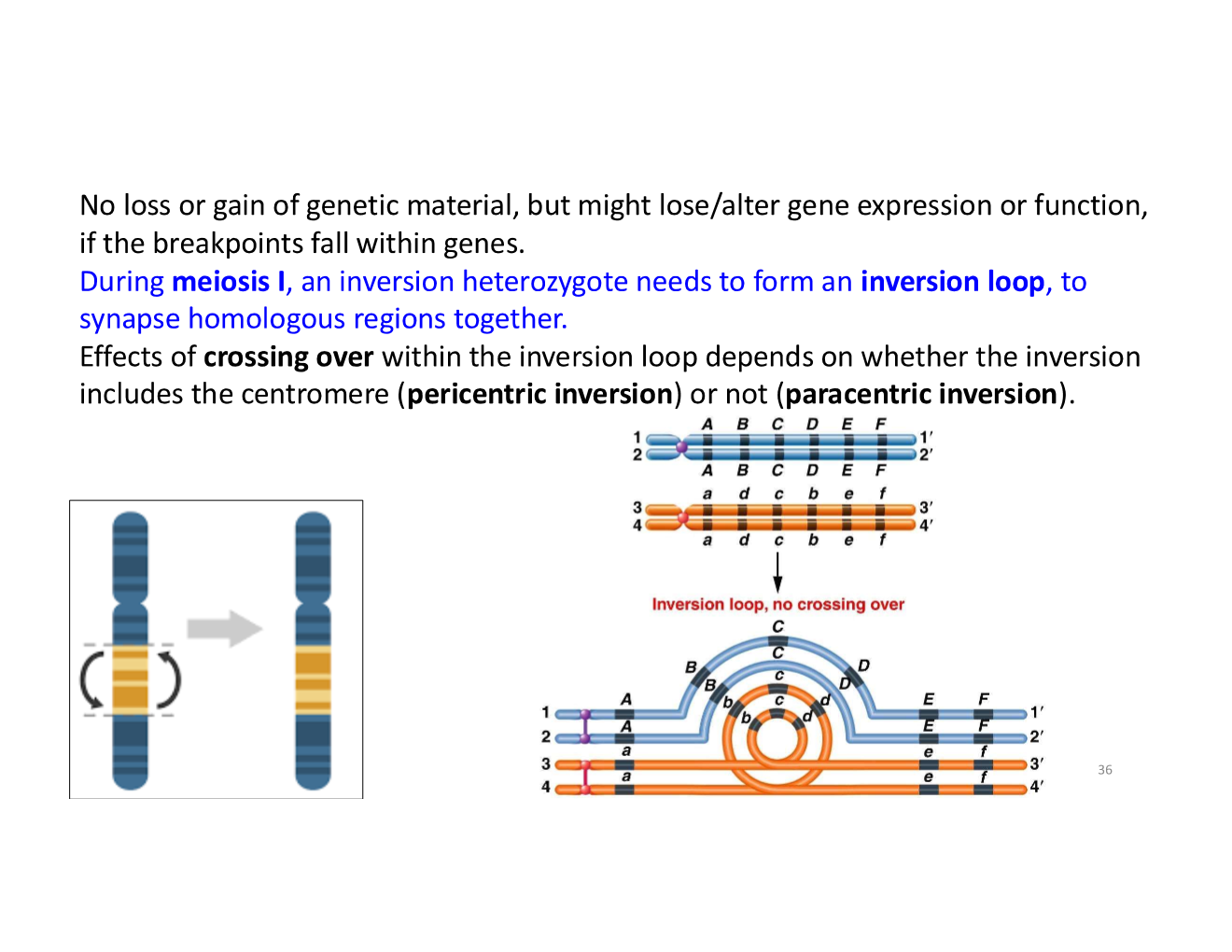
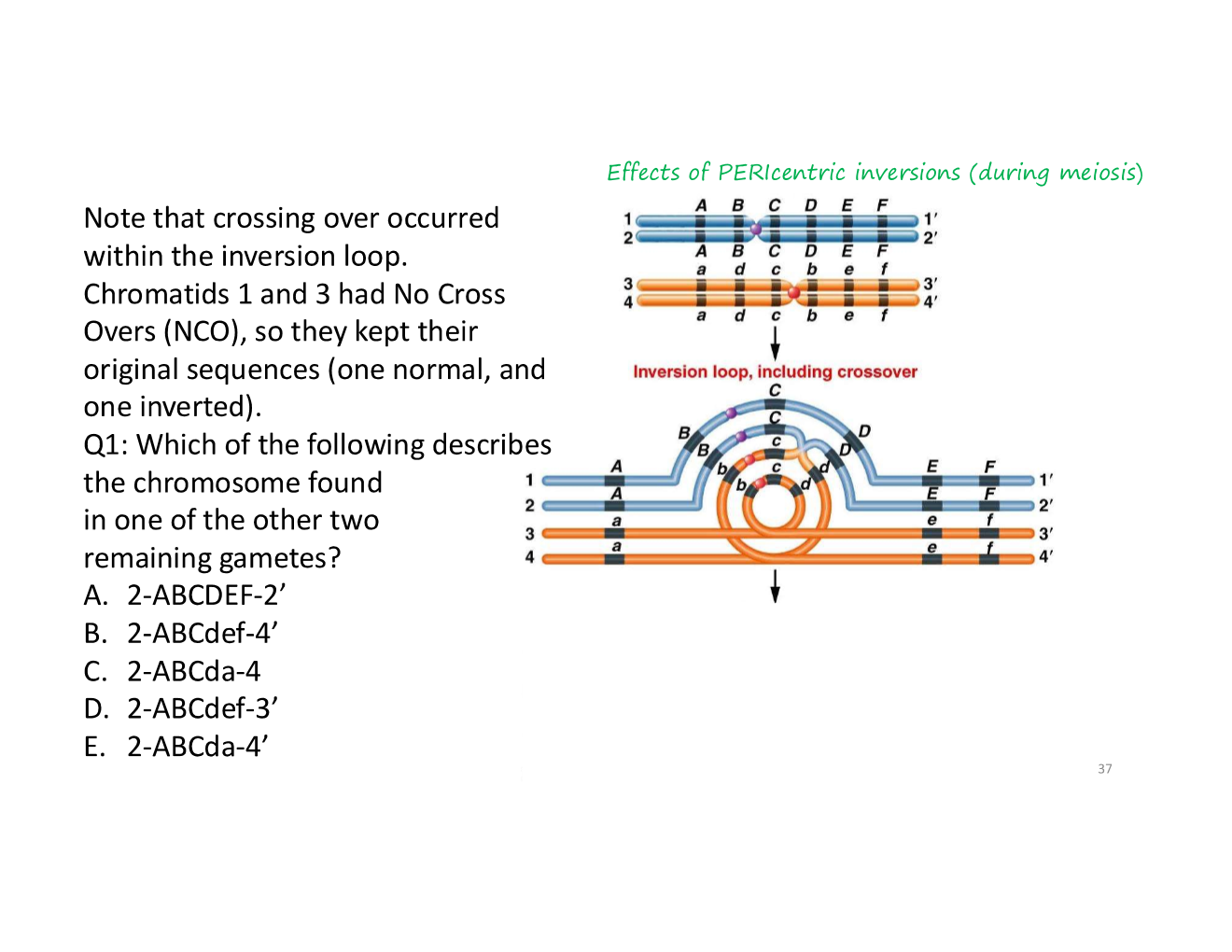
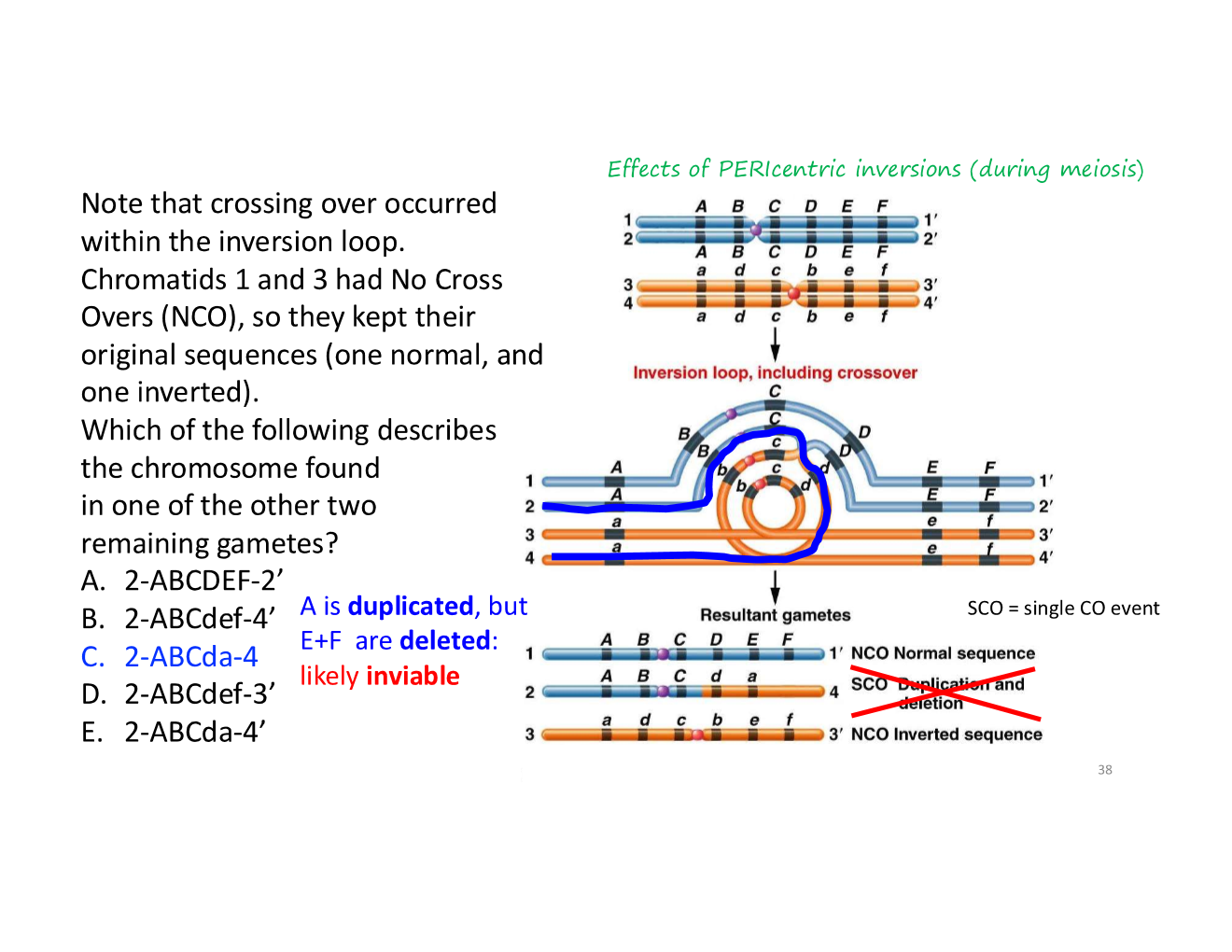

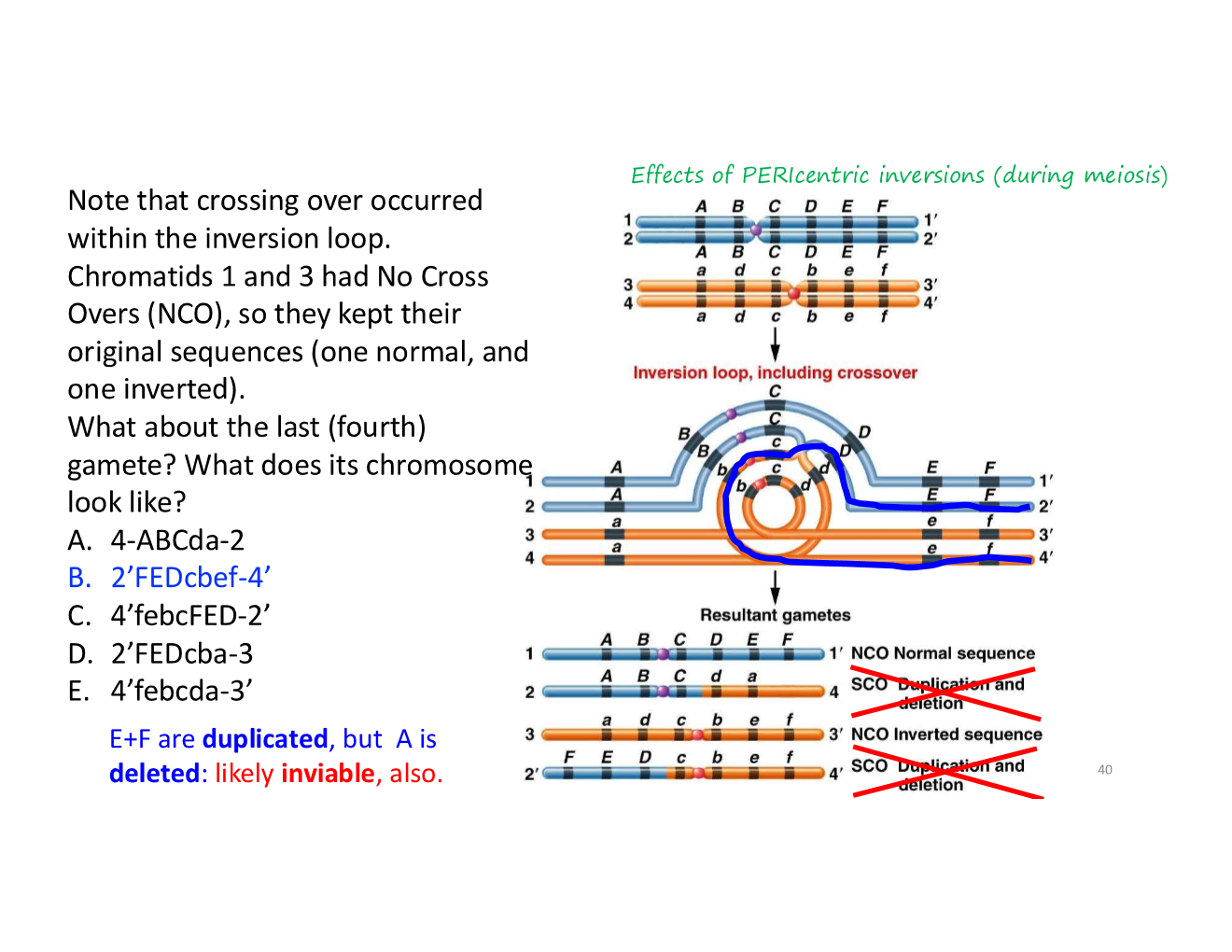
acentric
has no centromere
will likely create inviable offspring
dicentric
has 2 centromeres
dicentric chromosomes will be pulled in two directions and break at a random point
will likely create inviable offspring
what happens when a crossover occurs within an inverted region
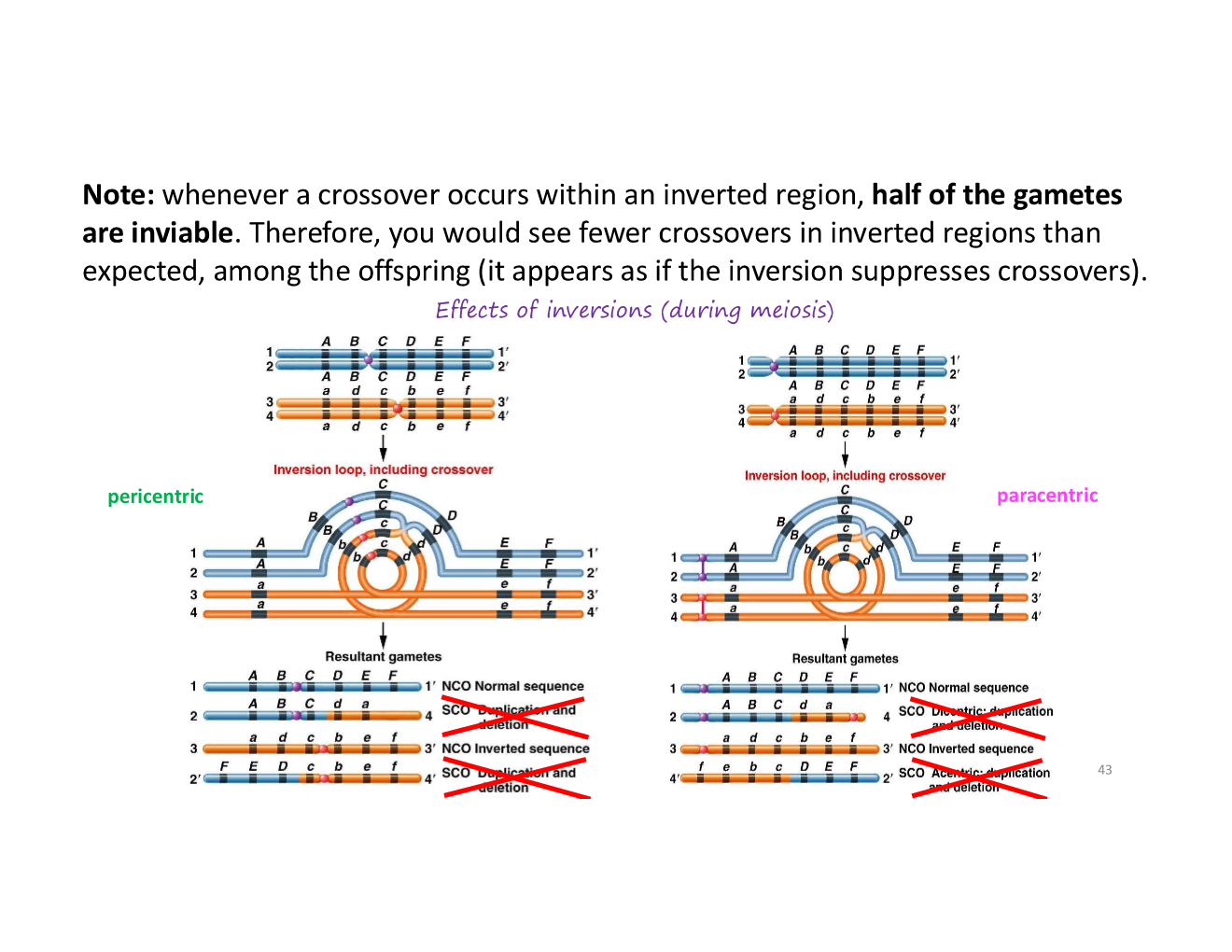
How can inversions or rearrangements affect genes if no genetic material is lost?
Gene expression or structure can be affected if breakpoints fall within genes, disrupting their function.
What happens if chromosomal breakpoints don’t fall within genes during rearrangements?
The individual’s phenotype may appear normal, but reproduction may still be affected.
what happens when genetic material is lost?
there can be severe survival/phenotypic consequences, depending on which genes are lost

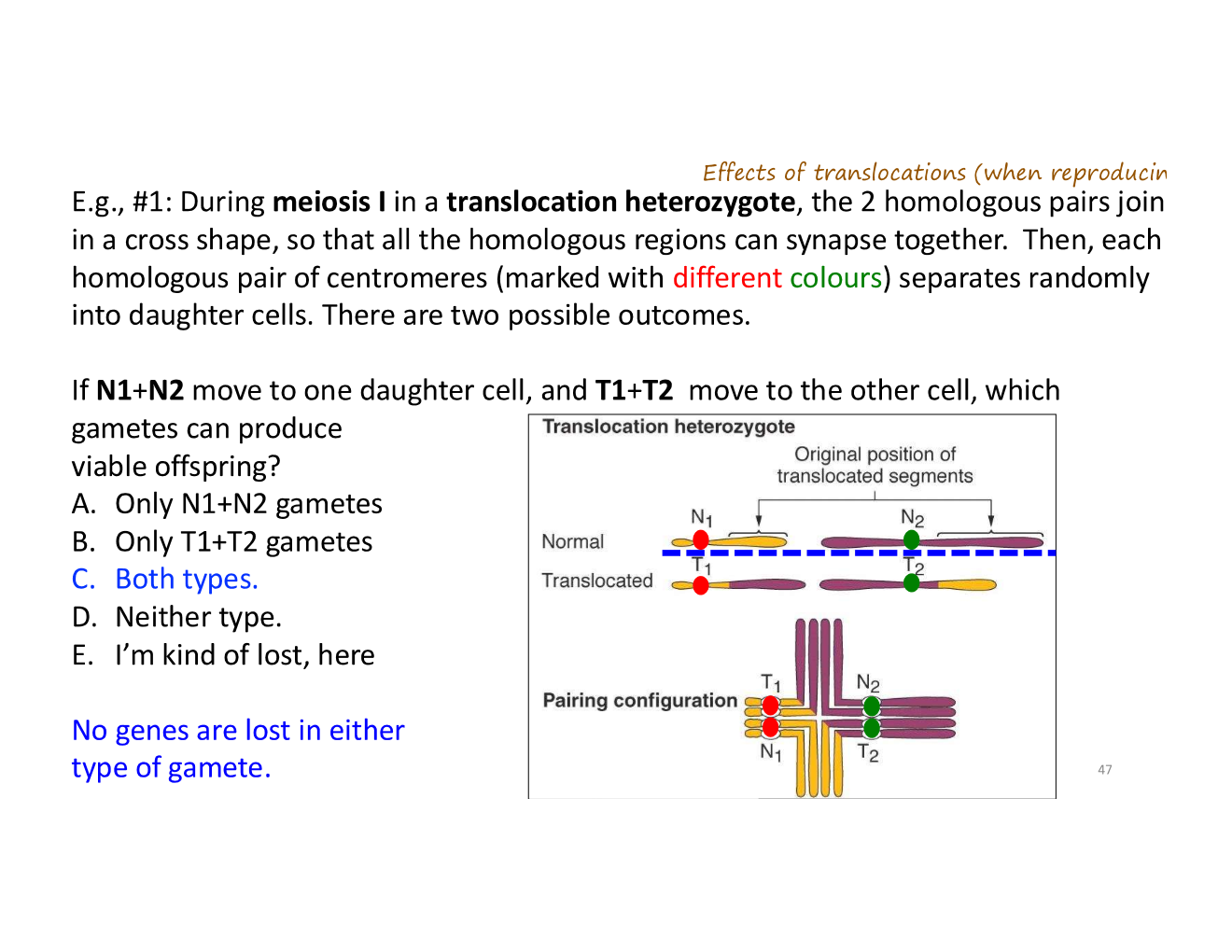
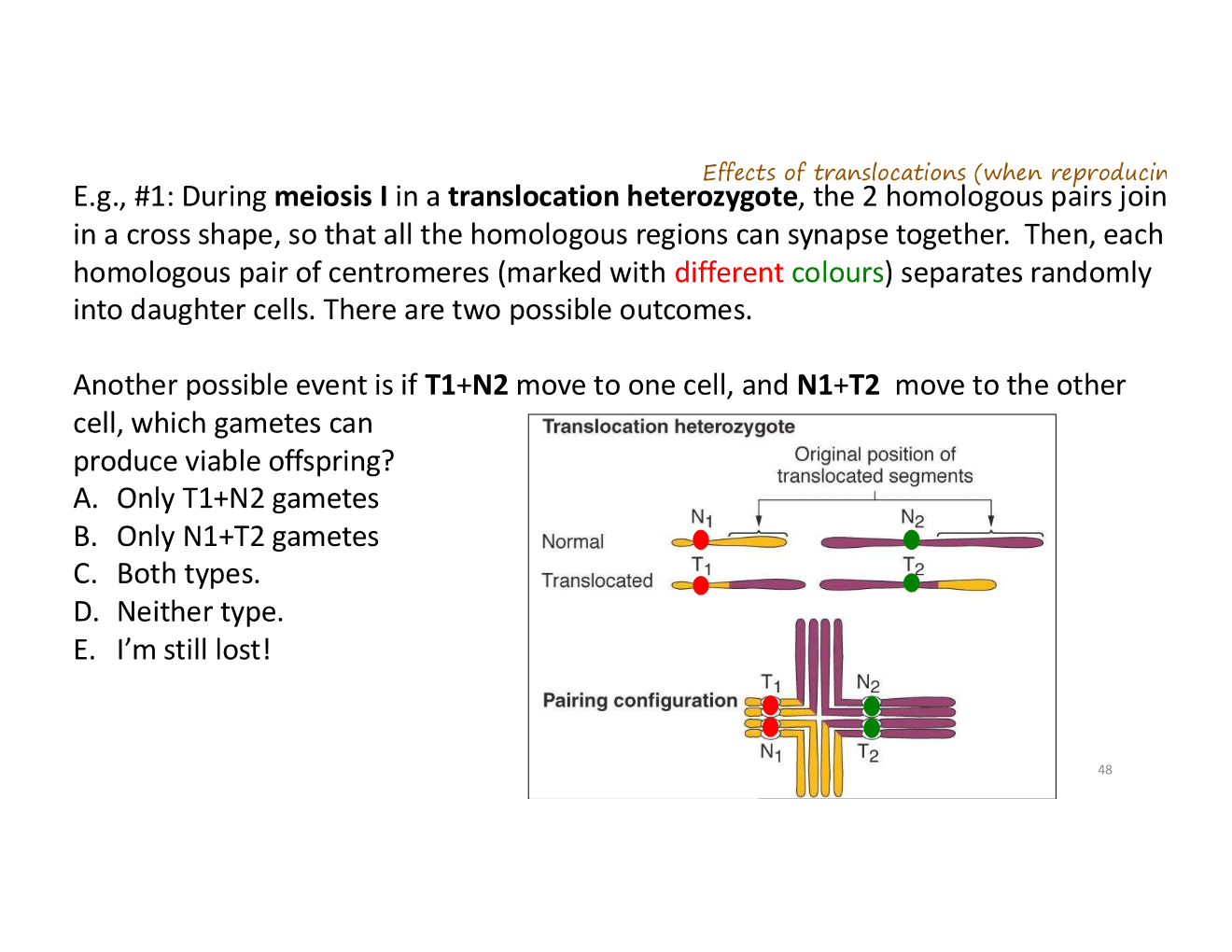
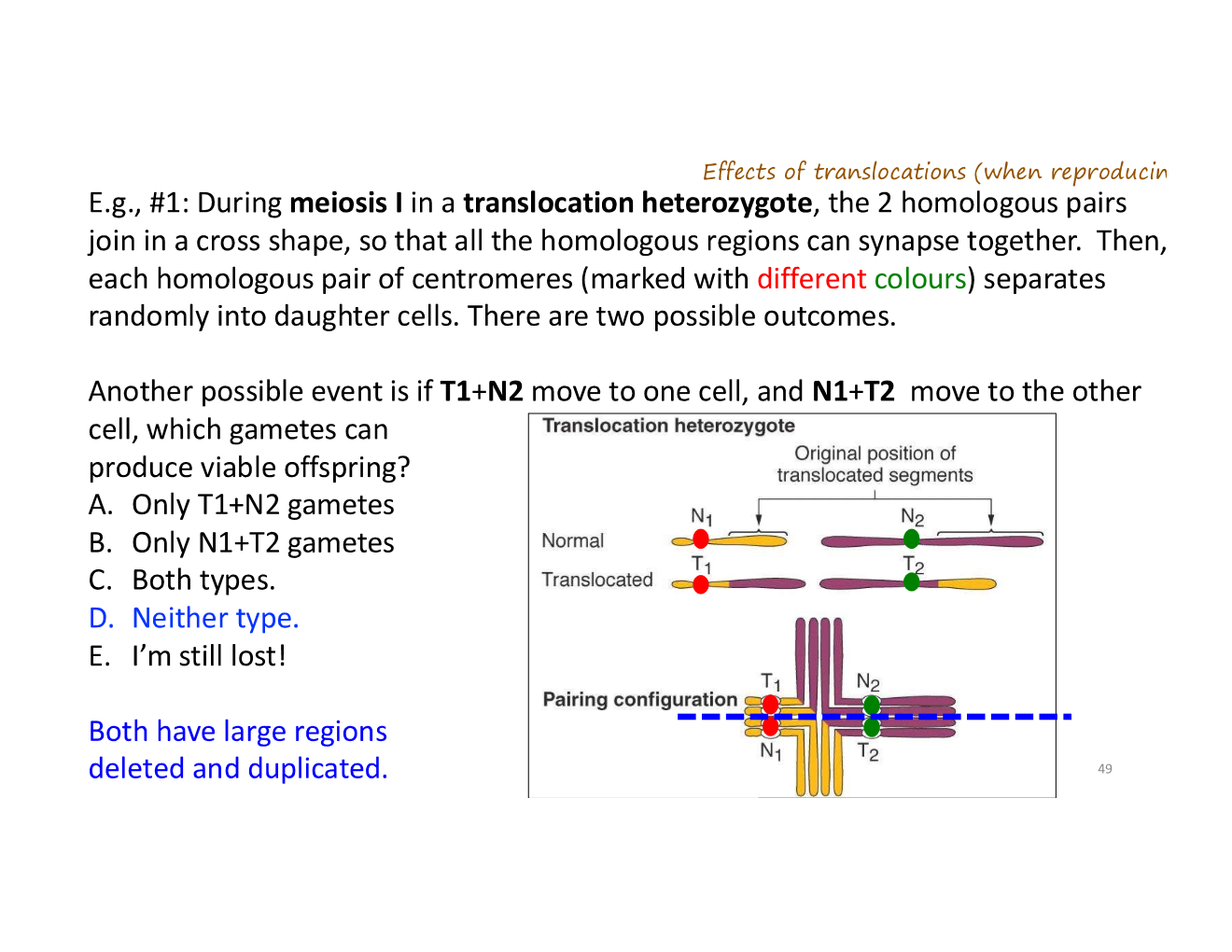
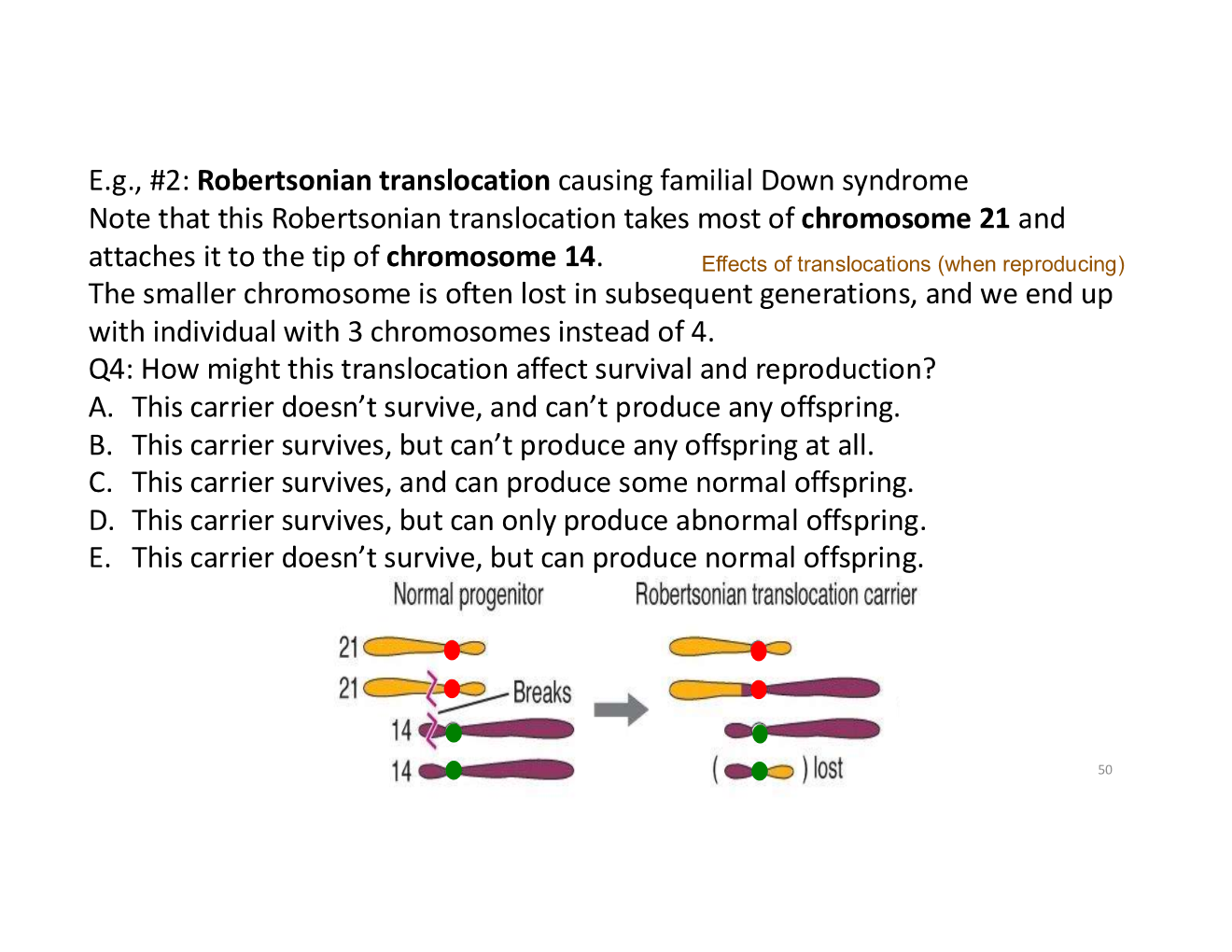
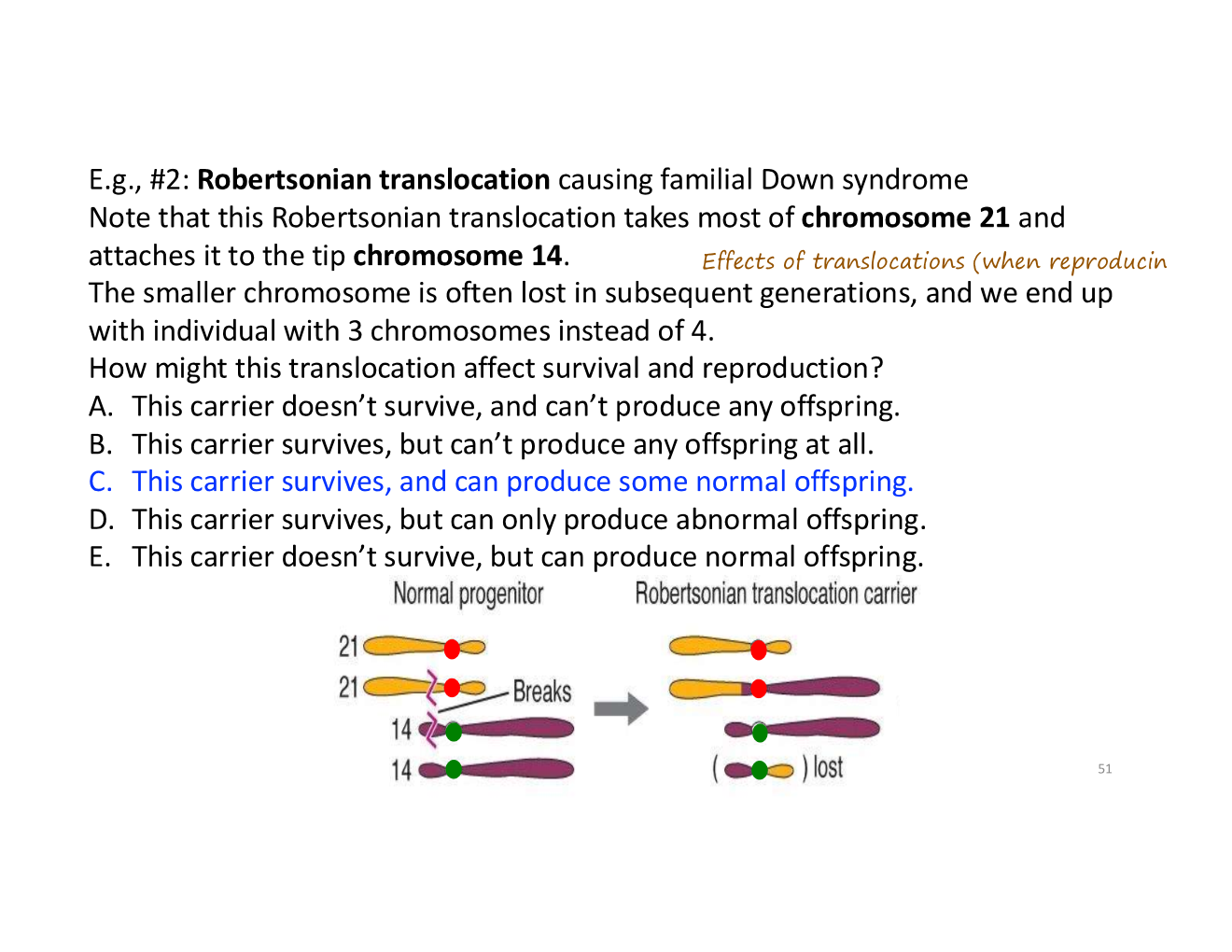
Robertsonian translocation
causes familial Down syndrome
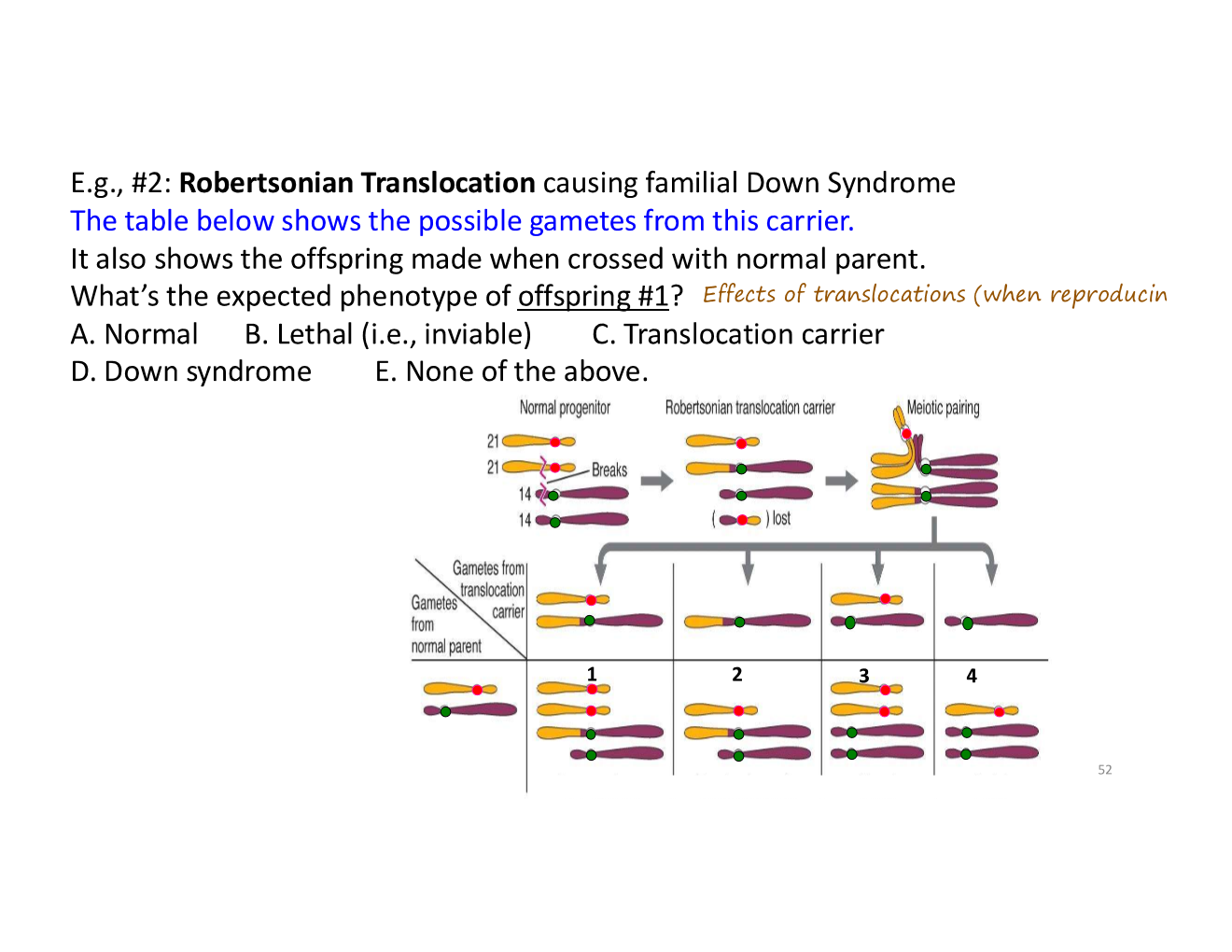
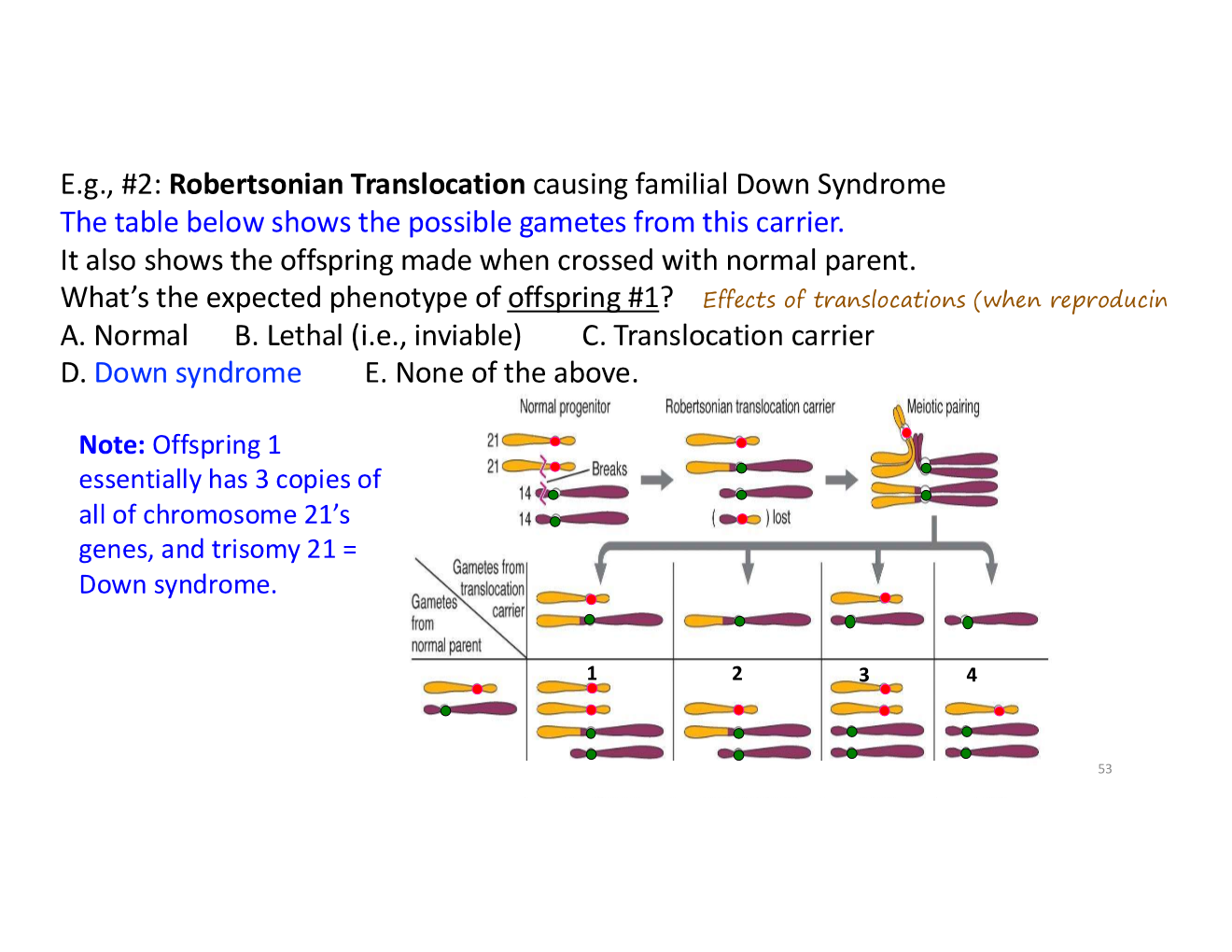
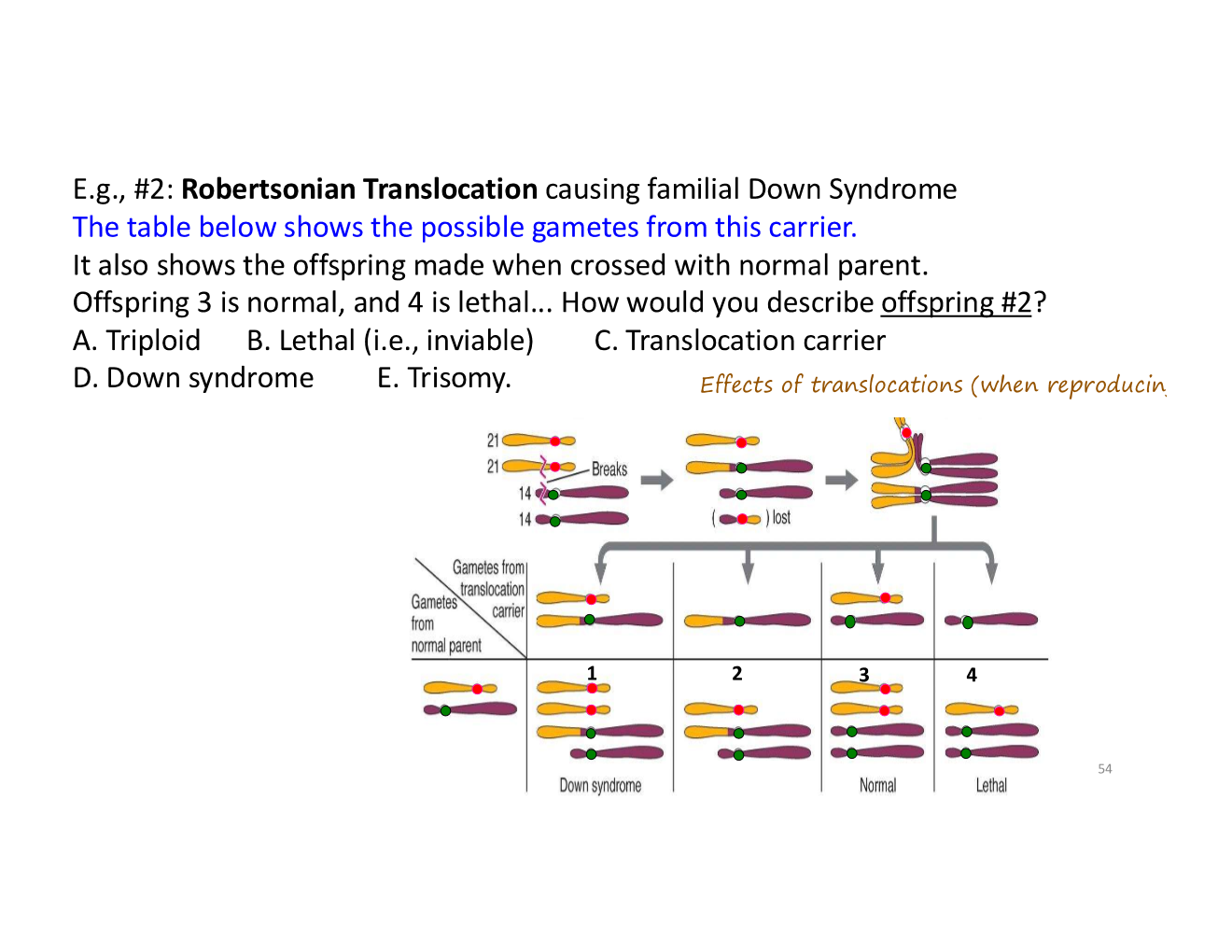

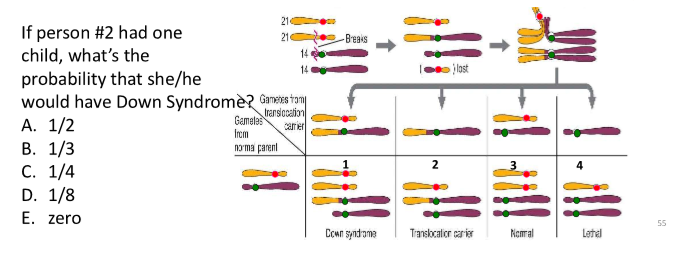

are human cells haploid or diploid?
diploid (2n=46) except when making haploid gametes (n=23) for sex
are amoeba haploid or diploid
haploid n=30
are fungi haploid or diploid?
haploid (n), except when briefly joining another cell (from different mating type) to make a diploid cell (2n) to have sex (e.g., exchange DNA) before becoming haploid (n) again
tetraploid
4n
hexaploid
6n
decaploid
10n
triploid
3n
polyploidy
more than just two genomes
odd-numbered polyploids
are sterile (and so “seedless”)
prokaryotes

extra-nuclear dna
besides the linear chromosomes eukaryotes have in each somatic cell’s nucleus, we also have extra-nuclear DNA in mitochondria (for animals, plants, and some protists) and in chloroplasts (for plants, and some protists)
extra-nuclear DNA looks like prokaryote DNA
endosymbiotic theory
our ancient single-celled ancestors engulfed prokaryotes?